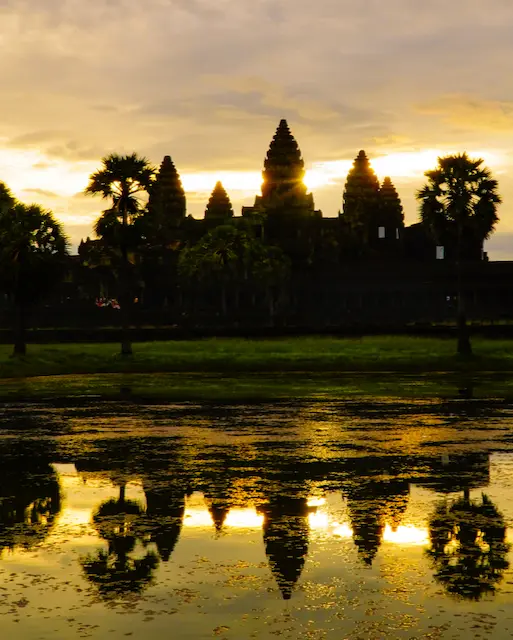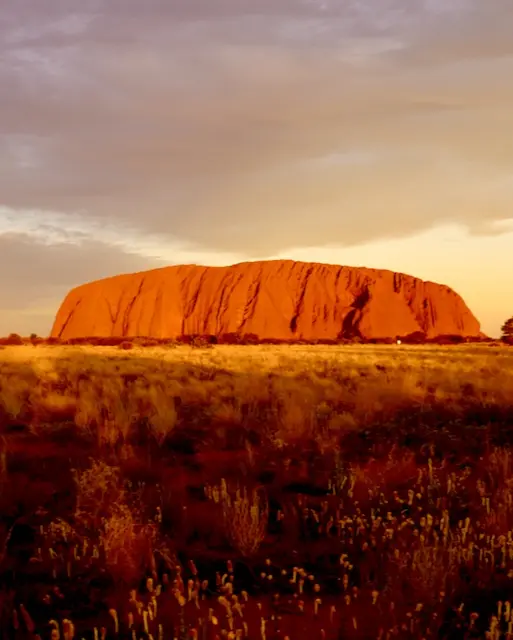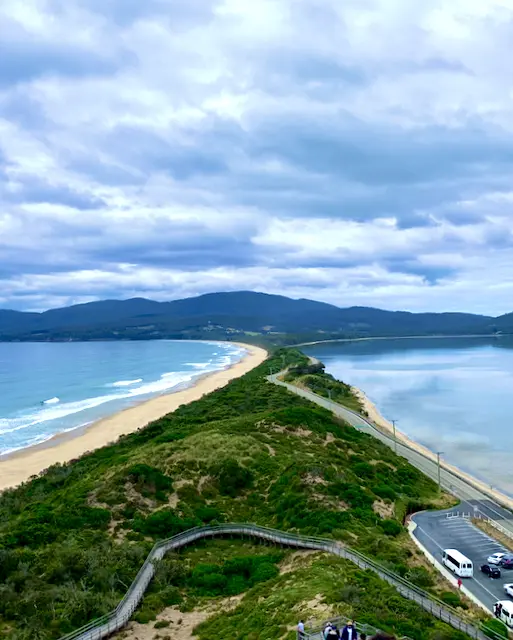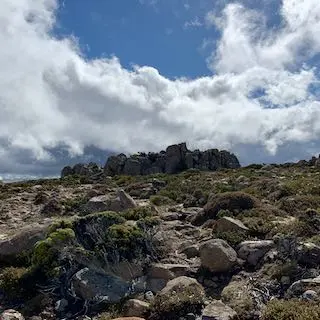Angkor Wat, Cambodia's Stunning Stone City
Complete guide to exploring Angkor Archaeological Park.

Angkor Wat
Nestled amidst the lush jungles of Cambodia’s Siem Reap province, you’ll find the enchanting spires of an ancient stone city reaching for the skies, nestled within the expansive Angkor Archaeological Park.
Once the bustling heart of the Khmer Empire from the 9th to the 15th centuries, this breathtaking site spanned an empire stretching from Myanmar to Vietnam, with its hidden wonders covering over 400 square kilometers, including both dense forested areas and recently unearthed “suburban” remains.
Amidst the multitude of temples and structures, the grandeur of Angkor Wat stands out. This colossal 12th-century “temple-mountain,” graced with intricate bas-relief galleries depicting captivating tales of Cambodian history and legend, holds a special place as Cambodia’s most iconic temple, even adorning the nation’s flag. It was originally crafted as a spiritual abode for the revered Hindu deity Vishnu.
As you explore Angkor, you’ll encounter not only these artistic wonders but also scenes portraying ancient daily life, offering a precious glimpse into Cambodia’s vibrant past. Every step through this historical oasis is a journey back in time, allowing you to connect with the rich tapestry of Cambodia’s cultural heritage.
Discover the ancient mysteries of Angkor, an extraordinary city shrouded in tales of vanished empires and resplendent temples. Curious minds have long pondered why its rulers left this majestic site, relocating near the vibrant city of modern-day Phnom Penh. Theories range from defeats in battles to evolving religious beliefs, with Hinduism giving way to Theravada Buddhism during the 13th and 14th centuries. Yet, the enigmatic secret remains, captivating explorers for generations.
Angkor isn’t just a testament of stone; it’s a love affair with water. Picture an intricate network of canals, dikes, and reservoirs, the most prominent being the expansive West Baray, stretching 5 miles long and 1.5 miles wide. Ingeniously crafted, these structures pay homage to religious symbolism, like the moats representing the vast oceans encircling Mount Meru, abode of the Hindu deities.
But these marvels of engineering were more than just symbolic—they were life-givers. Efficiently harnessing river and rainwater, they quenched the thirst of around 750,000 residents in this preindustrial giant of a city. Moreover, this precious water nurtured crucial crops like rice, acting as the currency of the Khmer civilization.
Some historians speculate that the decline of this elaborate water system may have marked the downfall of Angkor. A series of scanty monsoons or the collapse of these waterworks due to environmental strains, such as rampant deforestation, causing destructive floods and clogging the system with sediment, might have tilted the balance of power towards Phnom Penh.
Even in its twilight years, Angkor remained a beacon for Buddhist pilgrims from across Southeast Asia and beyond. Today, this ancient wonder draws secular travelers in droves, almost a million strong every year.
In 1992, Angkor was granted the prestigious title of World Heritage site but was sadly also added to the List of World Heritage in Danger. Rampant pillaging, illegal excavations, and lurking land mines threatened this incomparable treasure. However, a rallying cry for its restoration echoed worldwide, led by UNESCO in 1993. Through a textbook example of international collaboration, Angkor rose from the ashes, prompting its removal from the List of World Heritage in Danger in 2004.
The legacy lives on as UNESCO remains a guardian of Angkor’s destiny, partnering with Cambodian authorities to ensure that the waves of tourism and progress don’t wash away the sanctity of this awe-inspiring cultural gem.

How to Reach Siem Reap, Your Gateway to Angkor!
Getting to Siem Reap, the vibrant town that leads to the mesmerizing world of Angkor, is a breeze! Whether you’re an adventurer at heart or a comfort-seeker, there are several options for you. Hop on a comfortable bus or taxi from Phnom Penh, and in no time, you’ll find yourself in Siem Reap via well-maintained roads. For those yearning for a scenic journey, consider a boat ride from Phnom Penh, offering a picturesque voyage of about five to six hours—the same delightful travel duration as by road. Flying enthusiast? Siem Reap’s airport connects to Phnom Penh and even offers regular flights to neighboring countries like Thailand, Singapore, Vietnam, and Laos.
Explore Siem Reap and Experience Angkor!
Picture a blossoming town with Siem Reap, beckoning you to embark on an adventure to the ancient wonders of Angkor. This lively town is brimming with lodging options, delectable dining spots, and a range of tour packages to suit every budget and preference. If you’re up for a group exploration, convenient tour buses await to guide you through Angkor’s major highlights. But if you crave a more personalized journey, hiring a car or a motorbike with a friendly local driver and guide is the way to go. They not only take you to the iconic spots but also share exciting off-the-beaten-path adventures. And for an extraordinary view of the sprawling Angkor complex, consider a thrilling tethered balloon ride, granting you a bird’s-eye perspective like no other!
Best Time to Uncover Angkor’s Mysteries!
Timing is everything when it comes to uncovering the secrets of Angkor. The peak of the tourist season hits in December and January, offering pleasant weather with a lower chance of rainfall, making it an ideal time for exploration. As spring arrives, the temperatures start to soar, reaching their zenith in April, just before the monsoon season begins in May/June. Traveling during the monsoon can be a bit challenging due to the increased rainfall, but for the well-prepared and intrepid, it’s still an option. The post-monsoon season lasts until October, with sporadic rains that shouldn’t deter enthusiastic travelers. Just keep in mind that some remote roads may get a little muddy towards the end of the rainy season. Happy exploring!
Currency In Cambodia:
- KHR (1 AUD = 2637 KHR Approx)
Budget for 1 Week for 2 Persons:
- 2 Million KHR (Excluding flights)
Average Basic Expenses per day:
- Hotel: 100,000 KHR
- Food: 20,000 KHR PP
Itinerary:
-
Day 1
-
Day 2
-
Day 3
You may also like:
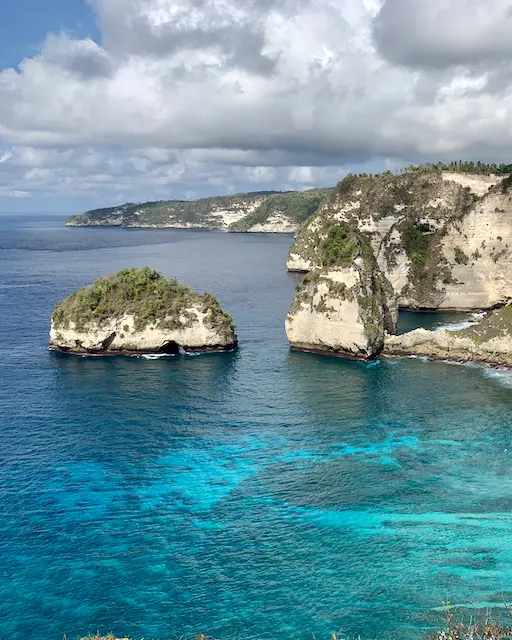
Two Weeks in Indonesia
Top 10 things to Do in Bali - Ubud - Nusa Penida - Gili - Komodo National Park

Day 1
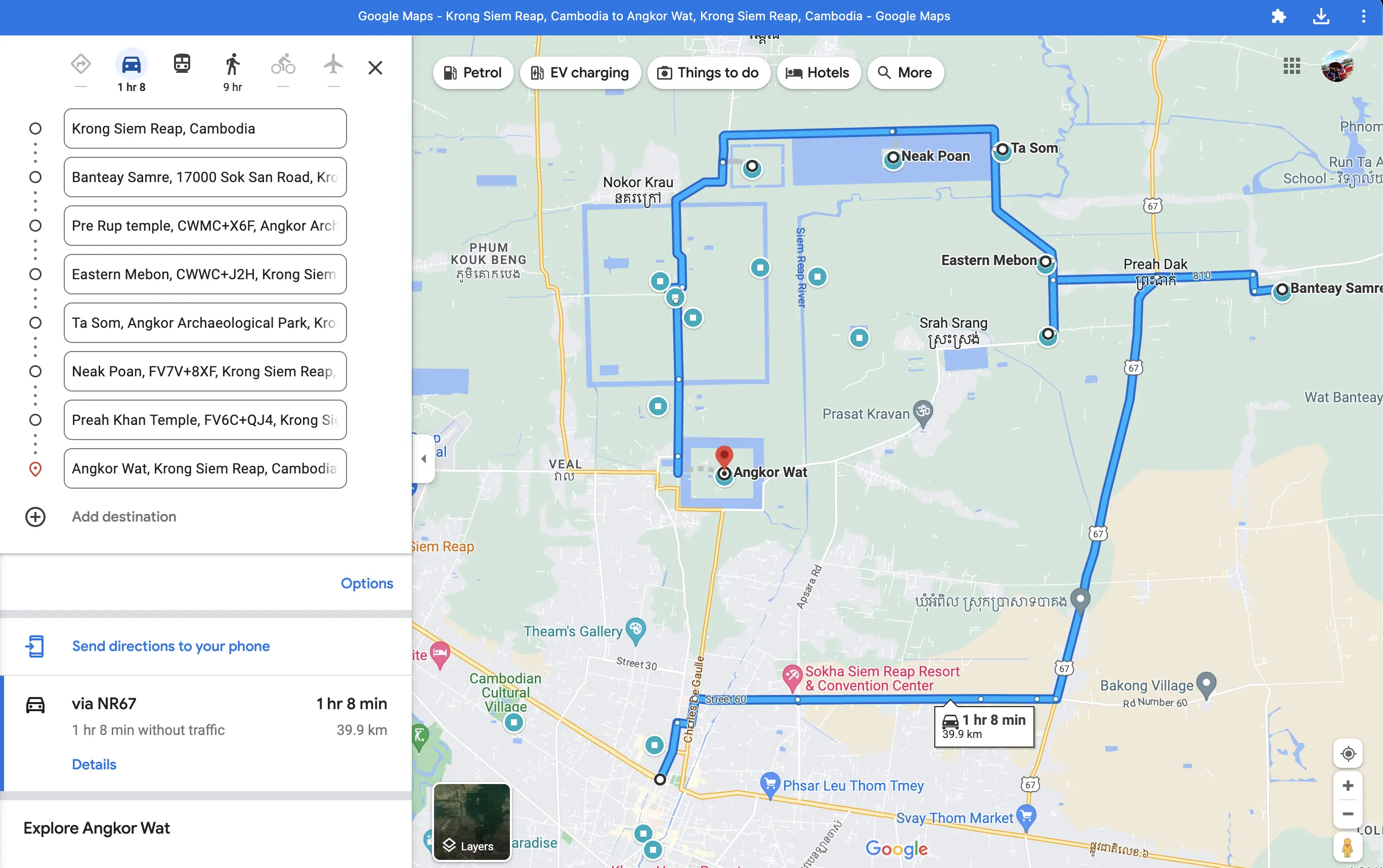
Angkor Wat Itinerary Day 1
Banteay Samre
The Citadel of the Samre
Discover the awe-inspiring beauty of Banteay Samre, a temple that’s well worth the extra effort to explore. Immerse yourself in its intricate architecture and delicate carvings, although sadly, some of the temple’s treasures have been marred by theft.
Located just 400 meters (1,312 feet) east of the East Baray, Banteay Samre awaits your adventure. Approach from the east and step into a world built in the middle of the 12th century by the visionary King Suryavarman II (reigned 1113-1150). This temple, dedicated to Vishnu in the style of Angkor Wat, reflects an era of ancient Hindu devotion.
The name “Samre” is a nod to the mountain-dwelling ethnic group that once inhabited the foothills of Phnom Kulen, likely connected to the Khmer culture. Although no inscriptions grace this temple, its architecture embodies the classic art of the middle period, reminiscent of Angkor Wat’s allure. It’s believed the monument hails from the same era, perhaps slightly later, with later Bayon-style additions.
Marvel at the exquisite proportions of Banteay Samre and embrace its unique feature—a captivating interior moat surrounded by laterite paving. Imagine the enchanting ambiance this moat would have created when filled with water, casting a surreal spell over the temple. The buildings encircling the moat rest on elevated bases adorned with ornate horizontal mouldings, showcasing figures framed by delicate lotus buds, inviting you into a world steeped in ancient wonder.

Banteay Samre
Pre Rup
City of the East
Welcome to the enchanting world of Pre Rup temple! Nestled in the northeast of Srah Srang and just a short 500 meters (1,640 feet) south of the south end of the East Baray, this ancient marvel awaits your exploration. As you approach from the east, a mesmerizing entrance beckons you to embark on a historical journey.
For the best visual treat, plan your visit early in the morning or during the captivating sunset when the warm hues of brick and laterite materials used in the temple come to life. Ascend to the upper terrace via the slightly less steep east stairway, revealing the stunning architecture in all its glory.
From the top terrace, you’ll be treated to two picturesque vistas. To the east, Phnom Bok and the majestic Phnom Kulen mountain chain await your gaze. Meanwhile, a glance to the west unveils the distant towers of the famed Angkor Wat, painting a truly awe-inspiring panorama.
Imagine this: In the latter half of the tenth century, precisely in 961, King Rajendraman II crafted this marvel, dedicating it to the revered god Siva. The architectural finesse of Pre Rup is unparalleled, boasting a fine balance, scale, and proportion. Its style closely resembles the East Mebon, albeit built a few years later. Often referred to as the ‘City of the East’ by Philippe Stern, a French enthusiast who worked on this historical site, Pre Rup stands as the last true ’temple-mountain.’
Unraveling the mysteries of ancient Cambodian beliefs, the locals have long associated this temple with funerary rituals, though the exact reasons remain shrouded in the sands of time. The very name ‘Prerup’ harkens to one of the cremation rituals, symbolizing the deceased’s silhouette outlined with ashes in various orientations. Delve deeper, and you may stumble upon the large vat at the base of the east stairway, possibly linked to ancient cremation practices. Join us as we venture into the captivating past of Pre Rup, a blend of history, architecture, and intriguing traditions!
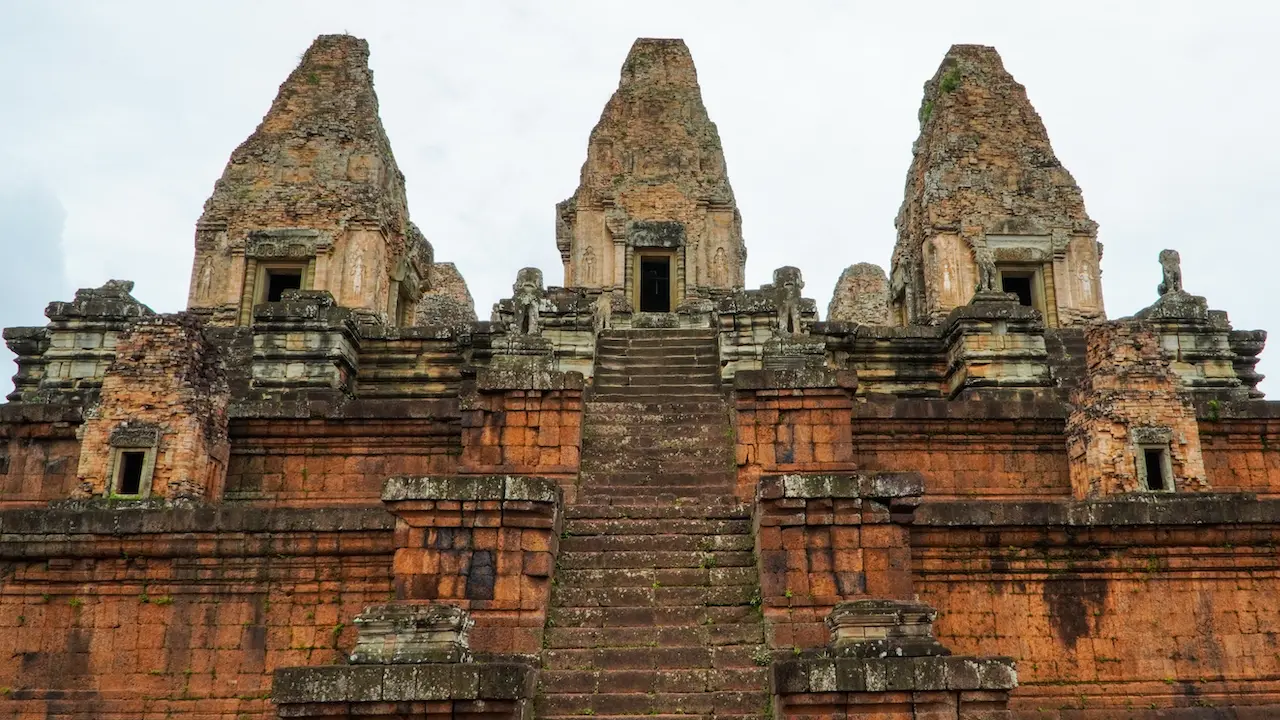
Prasat Pre Rup

East Mebon
A pyramid of receding terraces
Step into a world of ancient wonder at the Mebon Temple, a mesmerizing pyramid adorned with tiered terraces and elegant structures. At its pinnacle, five towers majestically adorn the sky, creating an awe-inspiring sight against the backdrop of a vast, water-painted sky. Picture a perfectly harmonized temple resting gracefully amidst a serene expanse of sky-reflecting waters.
Venture just 500 meters (approximately 1,640 feet) north of Pre Rup, and you’ll find the enchanting East Mebon temple. As you approach, enter through the welcoming eastern entrance and immerse yourself in the rich history dating back to the tenth century, precisely 952 AD. King Rajendravarman II dedicated this architectural gem to Siva, a Hindu deity, crafting it in the style of Pre Rup, a testament to familial reverence.
Imagine an island sanctuary in the heart of the Eastern Baray, a once vast water body spanning 2 by 7 kilometers (approximately 1.2 by 4.3 miles), nourished by the Siem Reap River. In ancient times, this temple was a secluded treasure accessible solely by boat. Today, the baray has transformed into picturesque rice fields, offering a glimpse into the temple’s former splendor amidst a sprawling lake.
The East Mebon boasts five towers, akin to the facets of a dice, perched atop a three-tiered base, all encircled by three protective barriers. These towers symbolize the mythical Mount Meru’s legendary five peaks, adding to the temple’s mystique and allure. Prepare to be transported to an age of divine elegance and timeless architecture as you explore this remarkable marvel.
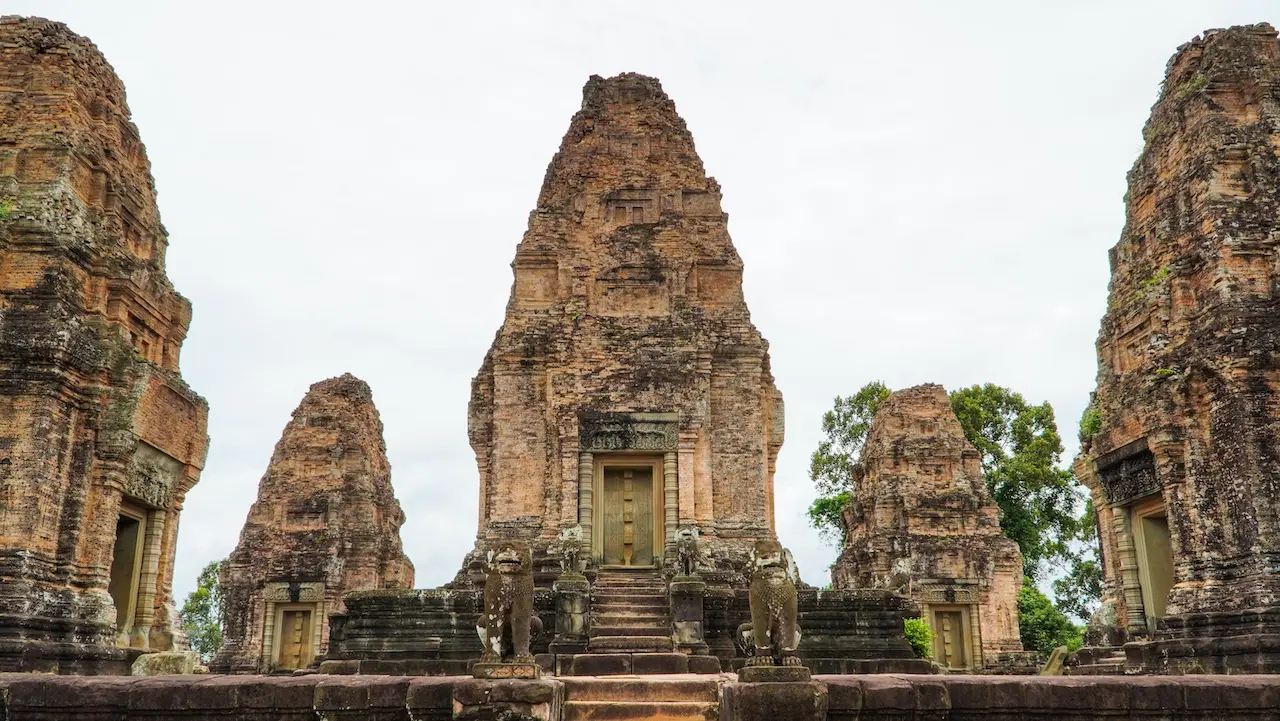
East Mebon
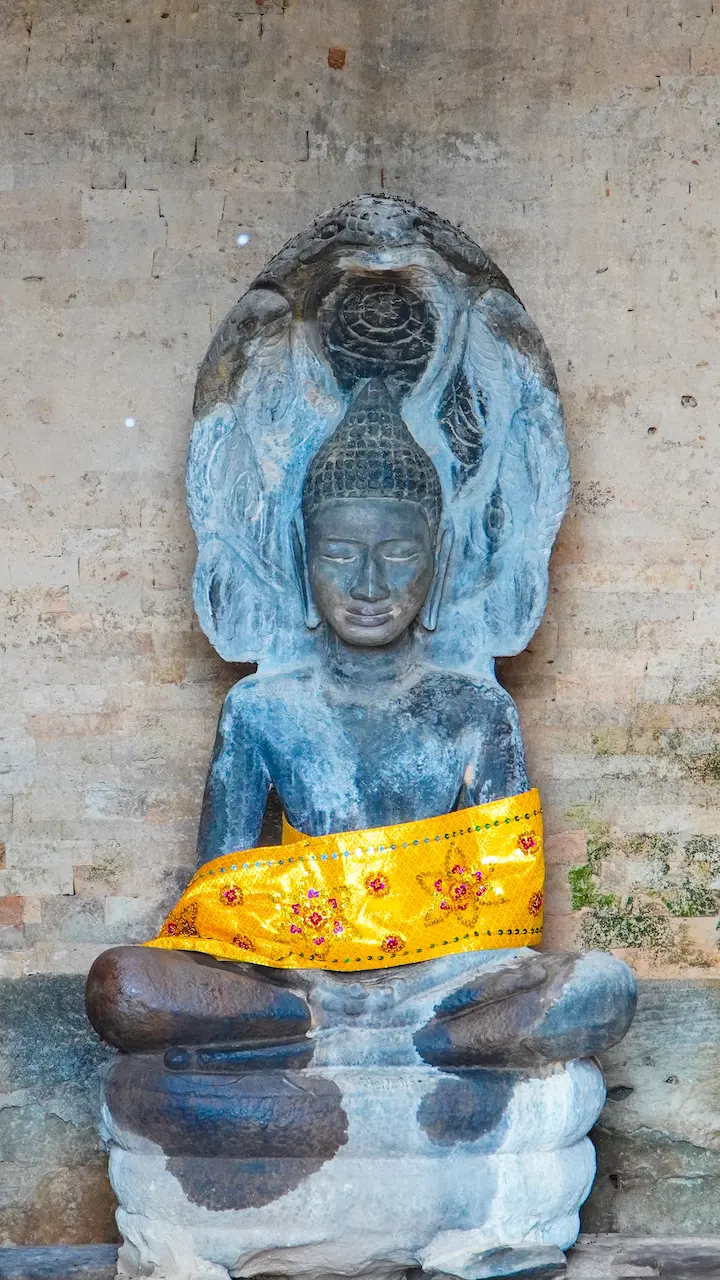
Buddha Statue in East Mebon Temple
Ta Som
The Ancestor Som
Nestled in the enchanting east of Nean Pean, you’ll discover the captivating wonder of Prasat Ta Som. To embark on your adventure, make your way through the mystical east entrance, for it’s the sole gateway to this hidden gem. This sacred sanctuary, erected in the late 12th century, pays homage to the king’s father and embraces the splendid Bayon art style.
As you step into the realm of Ta Som, prepare to be transported back in time. This modest yet untouched temple invites you to experience tranquility like no other. It’s a place where the whispers of history echo through the air, a perfect escape for those seeking serenity.
In days of yore, one of Ta Som’s most enchanting features was the majestic fig trees that adorned the entrance towers, their roots intertwining with the ancient stones. While the fig trees have bid farewell to the east tower, their mystique lives on, still gracing the west tower with their presence.
Ta Som unfolds before your eyes as a solitary tower, standing resolute on a single level. It’s encircled by three protective walls, offering entry points on both the east and west, each adorned with four mesmerizing faces. Keep an eye out for the radiant smile adorning the face on the right of the east tower, a welcoming gesture from centuries past. The entrance towers themselves take the form of a cross, featuring quaint chambers on either side, linked by rugged laterite walls.
Prepare to lose yourself in the captivating embrace of Prasat Ta Som – a hidden treasure that beckons the intrepid traveler to explore its ancient mystique.

Entrance to Ta Som
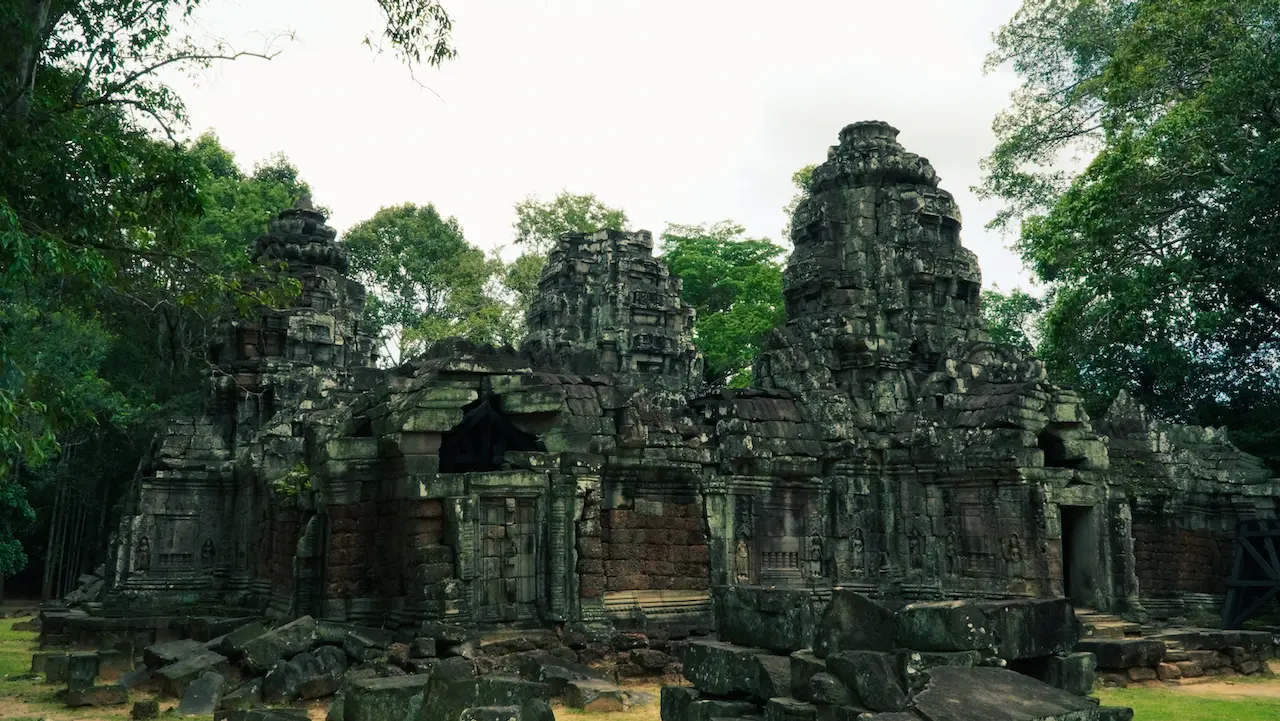
Ruins in Ta Som
Neak Pean
The coiled serpents
Imagine stepping into a time of opulence and beauty as you explore the enchanting Neak Pean Temple. Nestled amidst the awe-inspiring temples of Siva that drew men and armies, this tiny gem held a special allure. Eager princesses once graced it with their offerings of exquisite gold and fragrant perfumes.
Located to the east of Prah Khan, just 300 meters (984 feet) from the road, Prasat Neak Pean beckons with its charm. Enter through the inviting north entrance and be transported to the second half of the 12th century, a creation of King Jayavarman VII. Here, the dedication to Buddhism echoes the artistic style of Prasat Bayon.
Although Neak Pean may seem modest with its collection of five picturesque ponds, each visit unveils its unique and captivating features. Steeped in Buddhist reverence, this sanctuary is believed to embody the spirit of Buddha’s journey to Nirvana.
At its heart lies a central pond, mirroring the mystical Lake Anavatapta cradled in the Himalayas, the zenith of the universe. This sacred lake is said to be the source of the earth’s four great rivers. At Neak Pean, sculpted gargoyles pay homage to these cardinal rivers. The ancient belief in the healing powers of Lake Anavatapta’s hot springs finds its artistic representation here.
Neak Pean showcases a grand square man-made pond, measuring an impressive 70 meters (230 feet) on each side, encased in elegant steps and encircled by four smaller ponds. At its heart lies a small circular island with seven laterite tiers, once graced by sculptures of majestic elephants at each corner. The central tower was a tribute to Avalokitesvara, adding to the temple’s mystique.
Visiting Neak Pean promises a journey into the ancient world, where history and spirituality intertwine, and the whispers of a bygone era echo through its hallowed halls.
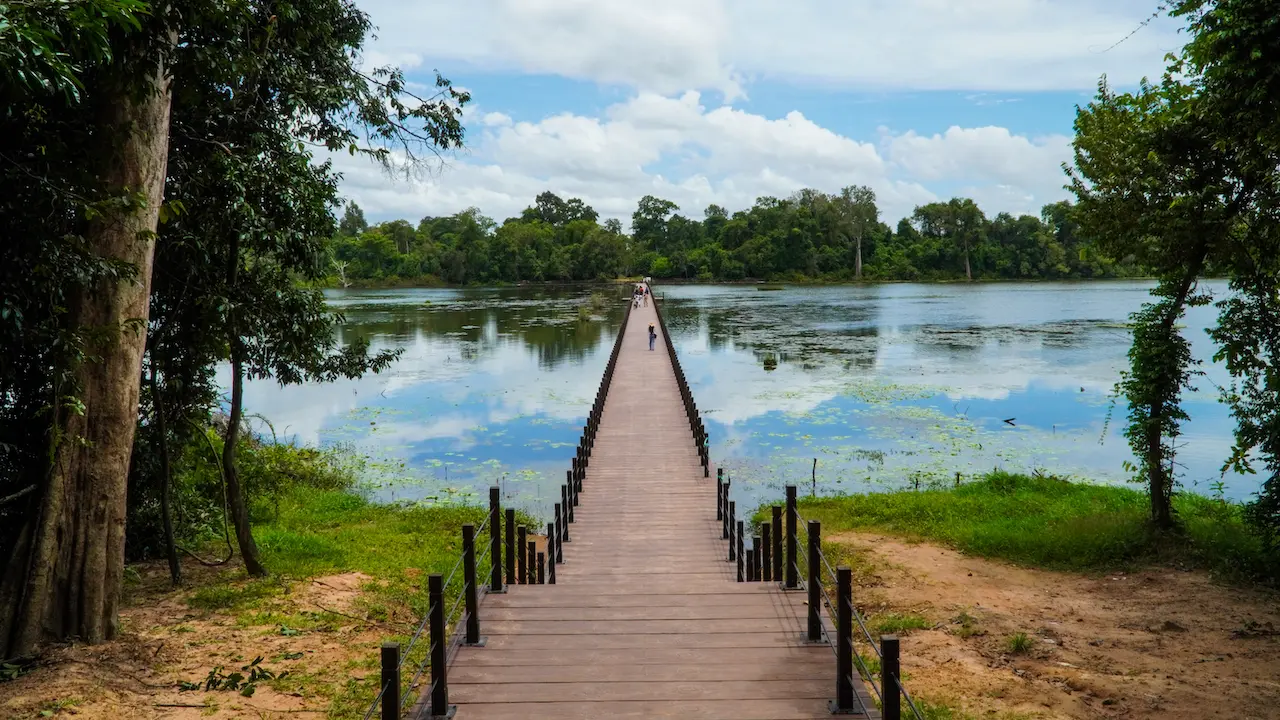
Into the Lake
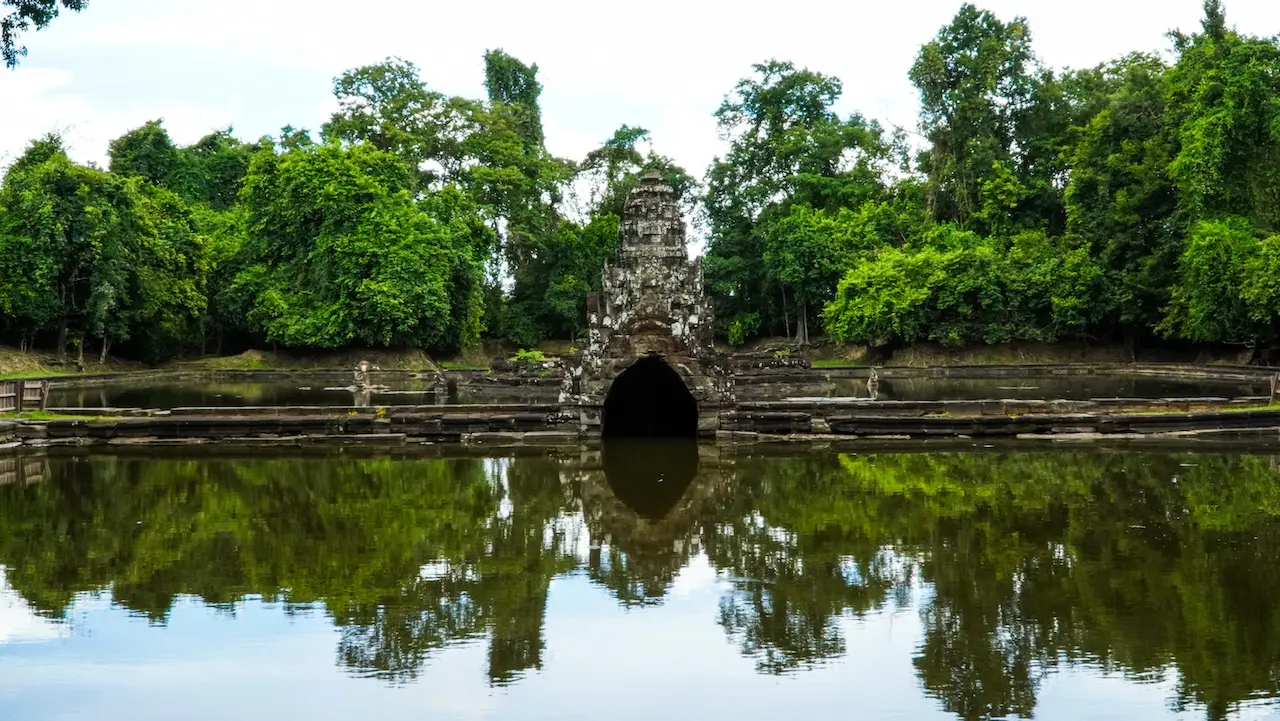
Neak Pean
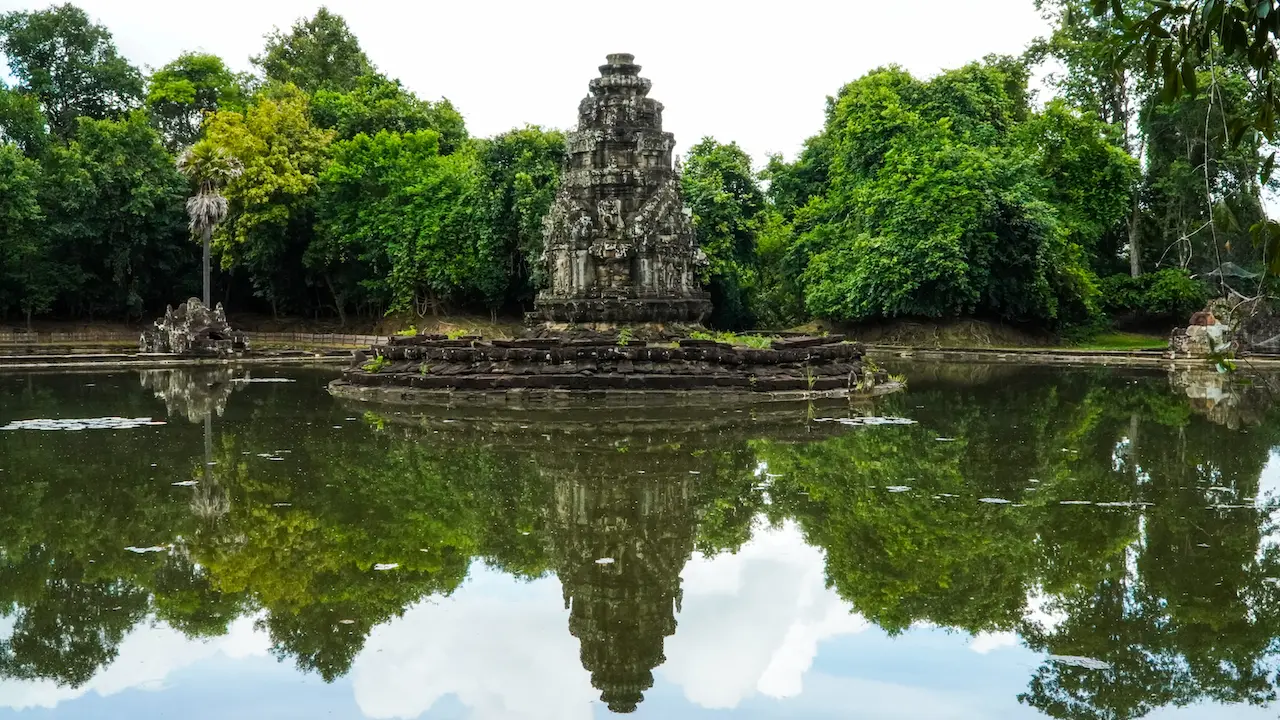
Central tower, tribute to Avalokitesvara
Preah khan
The Sacred Sword
Welcome to the enchanting world of Preah Khan Temple, a captivating ancient wonder located just 2 kilometers northeast of Angkor Thom on the Grand Circuit in Cambodia. Picture yourself stepping back in time to the second half of the 12th century, around AD 1191, when this awe-inspiring temple was constructed by the visionary King Jaya-varman VII. It was a heartfelt dedication to his father, Dharanindravarman, and stands as a testament to a rich and fascinating history.
Spanning across an expansive 56 hectares, the Preah Khan temple complex was the heart of a vibrant community, accompanied by neighboring sites like Neak Pean and Ta Som. These remarkable landmarks are nestled around the breathtaking 4-kilometer-long Jayatataka Baray, the final grand reservoir built during the era of Angkor.
Legend has it that Preah Khan Temple was erected on the very grounds where the triumphant King Jaya-varman VII defeated the Chams, a victory so significant that the site was then known as Nagarajayacri, signifying the city of Preah Khan.
Imagine exploring the temple through four remarkable ramparts. The outermost wall, surrounded by a tranquil moat, now embraces a lush expanse of jungle, once home to monks, students, and the devoted attendants of Preah Khan. The religious epicenter, encompassing about four hectares, is enclosed by the second rampart, offering a mesmerizing concentration of temples and shrines. The heart of this complex is dedicated to Buddhism, while the northern and western sectors pay homage to Brahmanism—Vishnu to the west and Shiva to the north. A sacred space for ancestor worship resides in the southern sector, while the grand entrance to the central shrine graces the eastern sector.
As you wander the area, discover Veal Reacheak or Preah Reachea Dak, a regal location near Preah Khan Temple, stretching an impressive 1,500 meters in length and 1,200 meters in width. Venture about 700 meters north of Preah Khan Temple, along the road to Angkor Thom district, and stumble upon the charming Ptu temple, crafted from the enduring laterite, inviting you to unravel more secrets of this mesmerizing land.
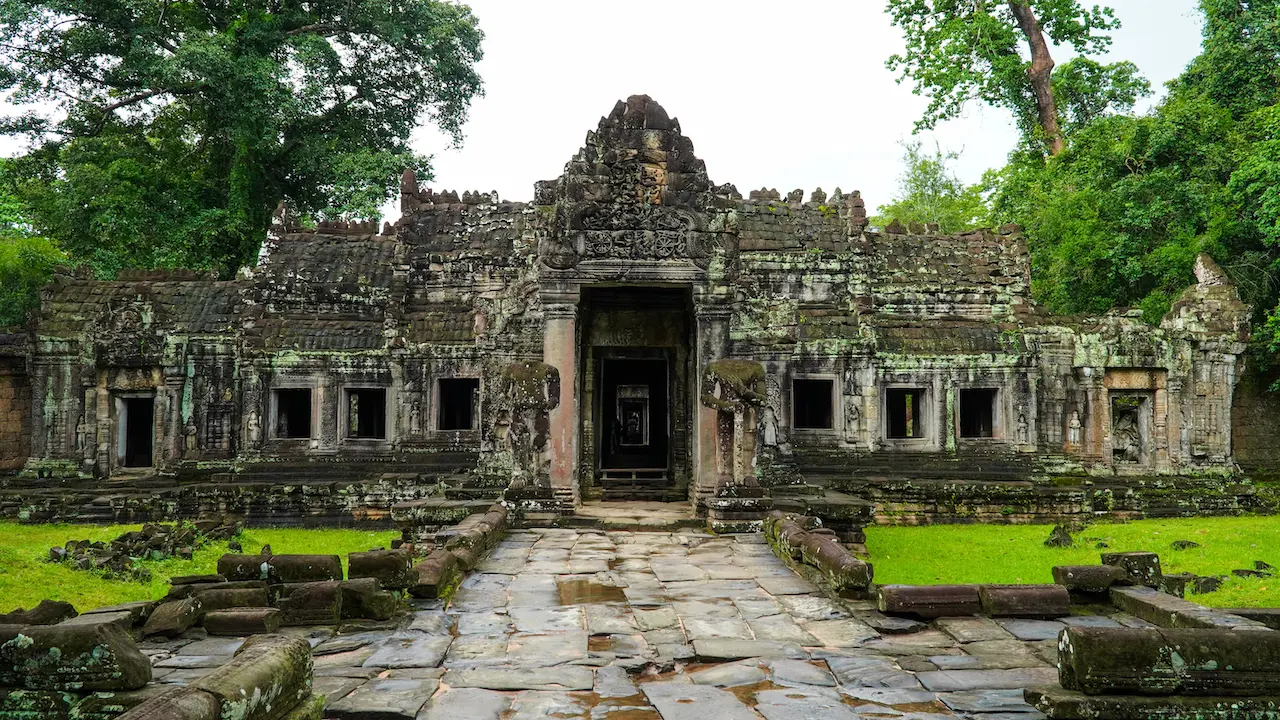
Preah Khan Temple
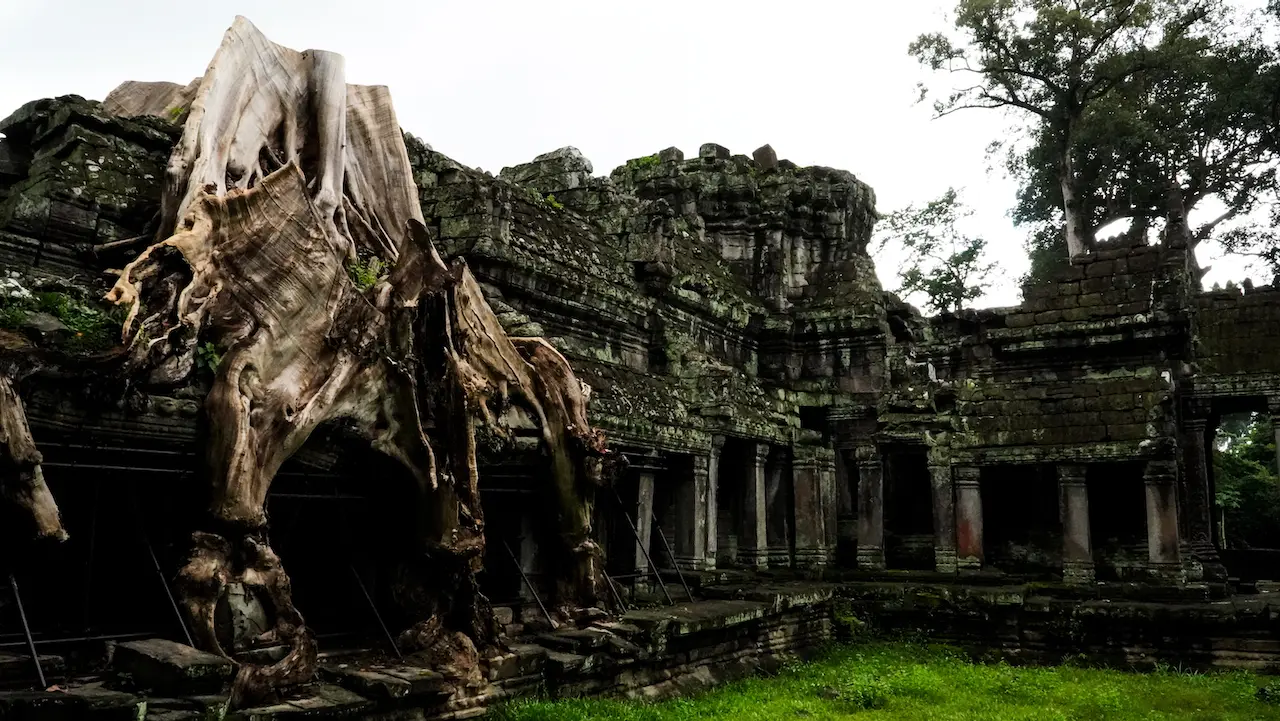
Tree grew on top of Preah Khan
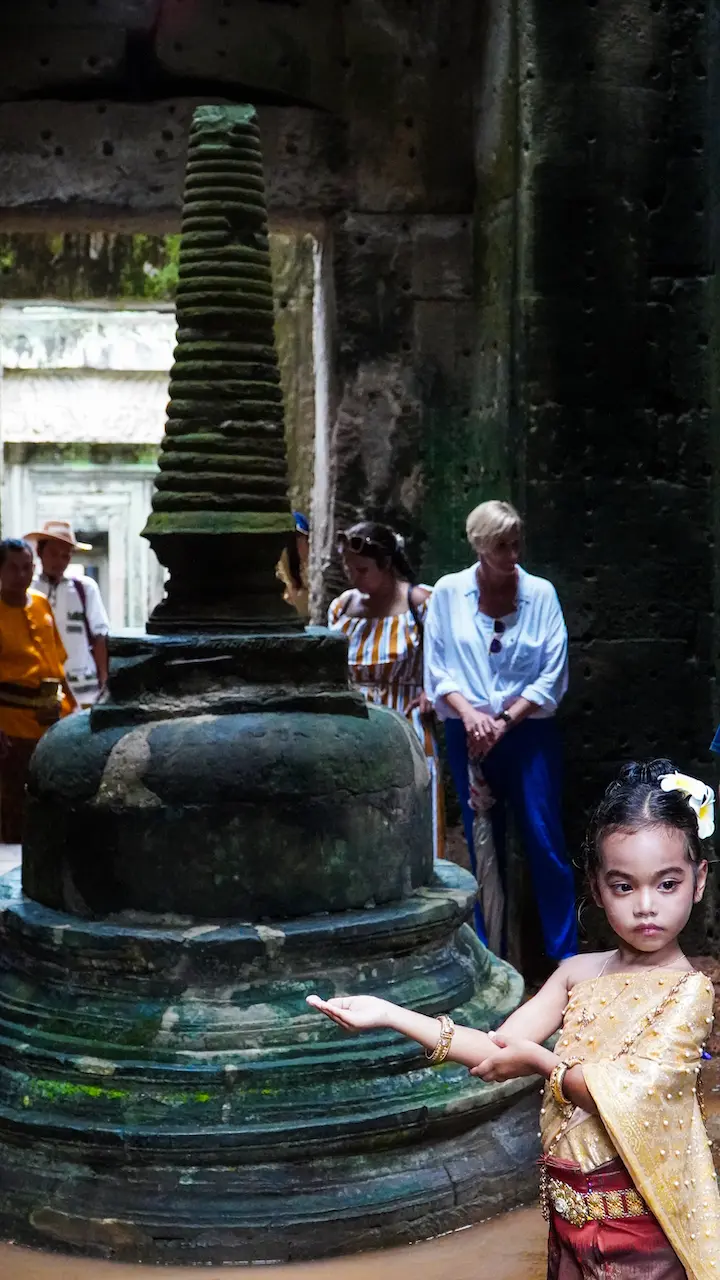
Cambodian kid posing for a photo
Angkor wat
Cambodia’s Stunning Stone City
Welcome to the captivating realm of Angkor Wat, a stunning architectural gem built during the early 12th century (113-5BC). King Suryavarman II poured 30 years of meticulous craftsmanship into this temple dedicated to Vishnu, following the elegant Angkor Thom style of art.
Among the vast Angkor complex, Angkor Wat reigns as the largest and most immaculately preserved monument. Its beauty lies in its perfect composition, harmonious balance, precise proportions, intricate reliefs, and breathtaking sculptures, rendering it a true masterpiece of architecture.
The name “Angkor Wat” beautifully translates to “City Temple,” with ‘Wat’ being the Khmer word for temple. Interestingly, this was influenced by Theravada Buddhism in the sixteenth century, adding to its mystique. After the capital moved to Phnom Penh in 1432, Buddhist monks lovingly maintained and cared for this sacred sanctuary.
Legend has it that Angkor Wat served as a funerary temple for King Suryavarman II, strategically aligned to the west to symbolize the setting sun and the journey into the afterlife. As you wander through its corridors, the captivating bas-reliefs narrate Hindu funerary rituals, guiding you through a mesmerizing journey of ancient beliefs and practices.
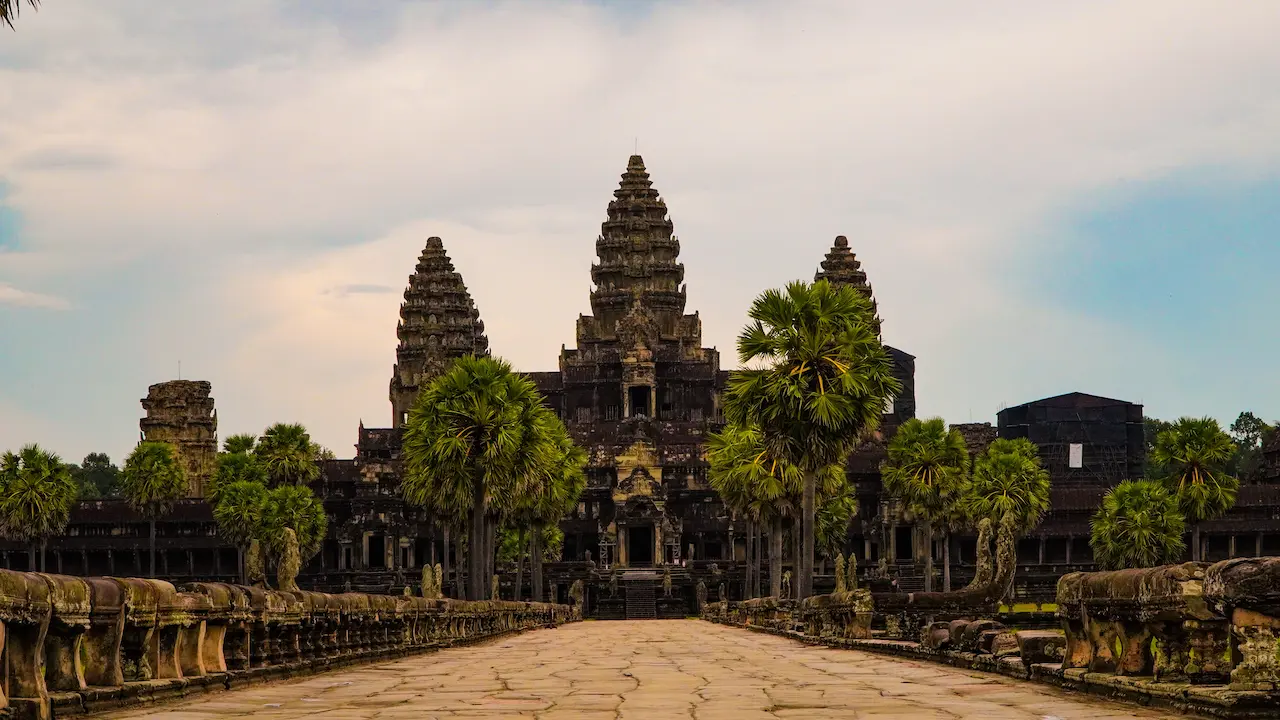
Angkor Wat
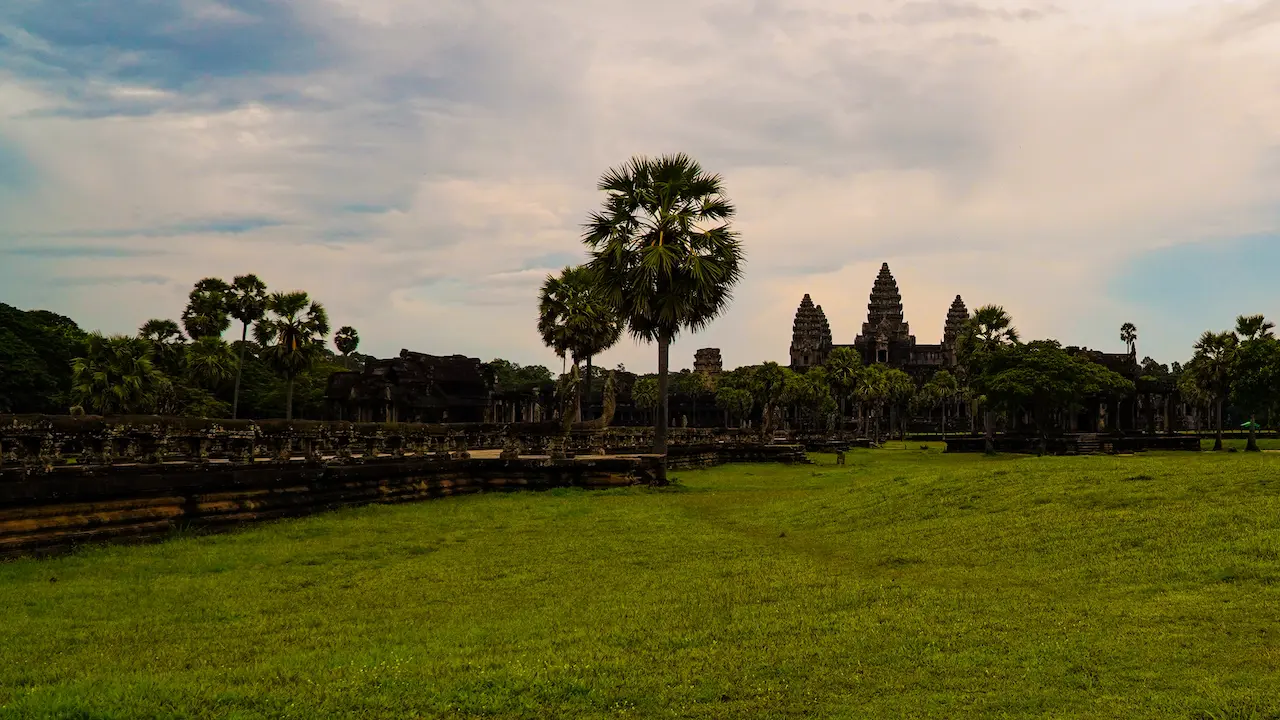



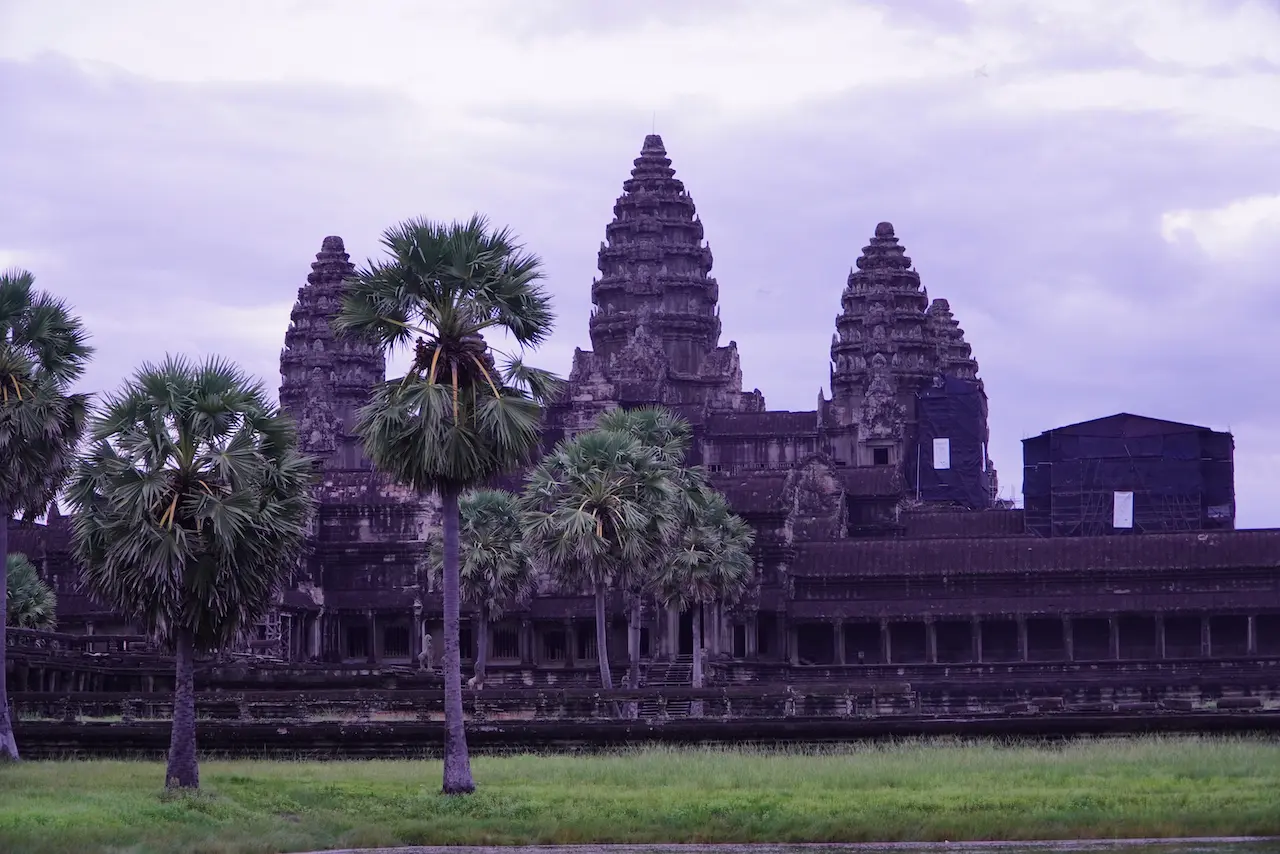
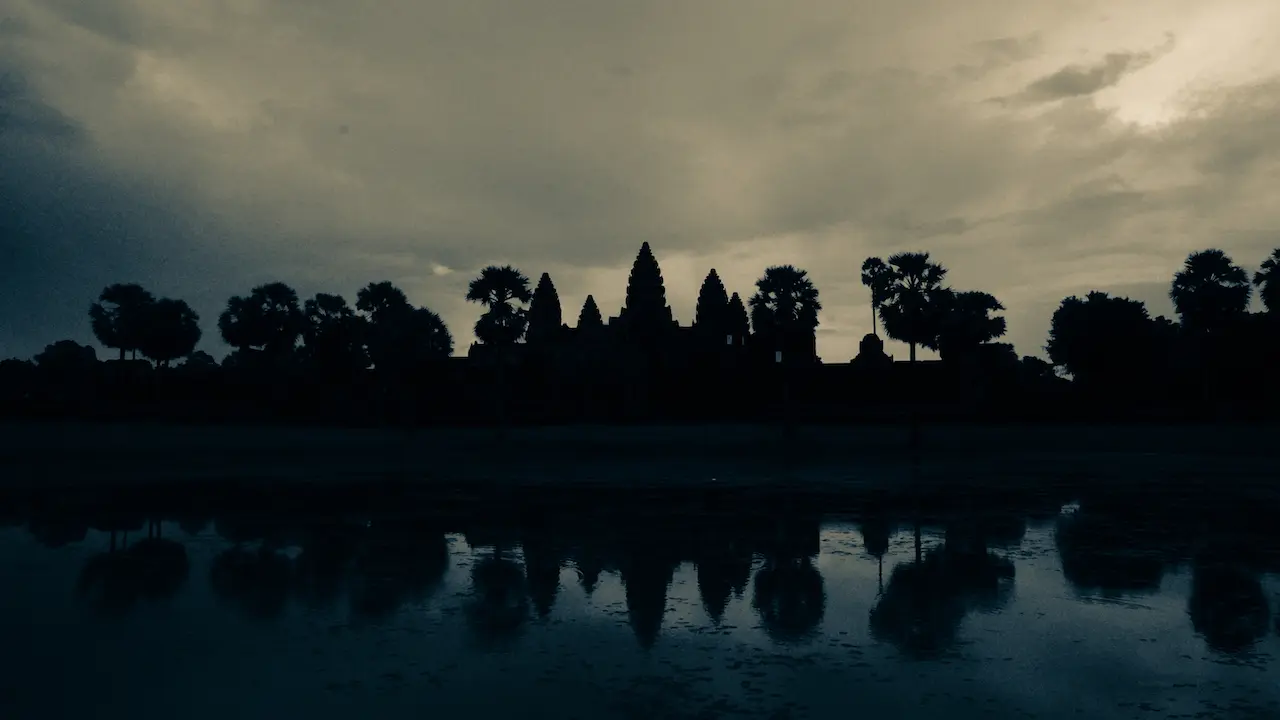
Angkor Wat after Sunset

Day 2
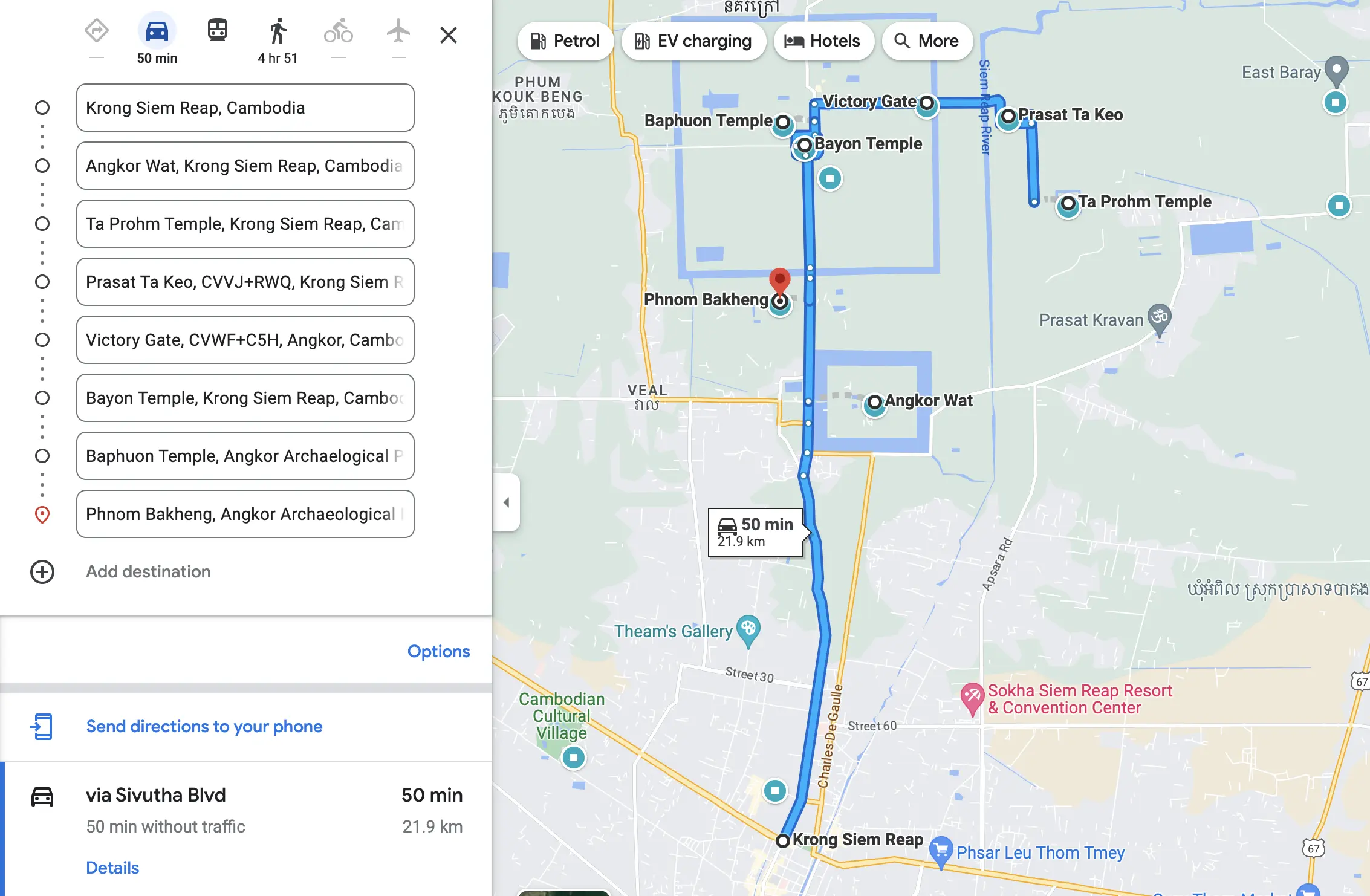
Angkor Wat Itinerary Day 2
Sunrise at Angkor Wat
Witnessing the sunrise at Angkor Wat is a magical experience, as the first light of day paints the ancient temple in hues of gold, creating a breathtaking and serene ambiance that transports you back in time. The ethereal play of colors and reflections in the temple’s pools makes for an unforgettable and soul-stirring start to your Angkor Wat adventure.
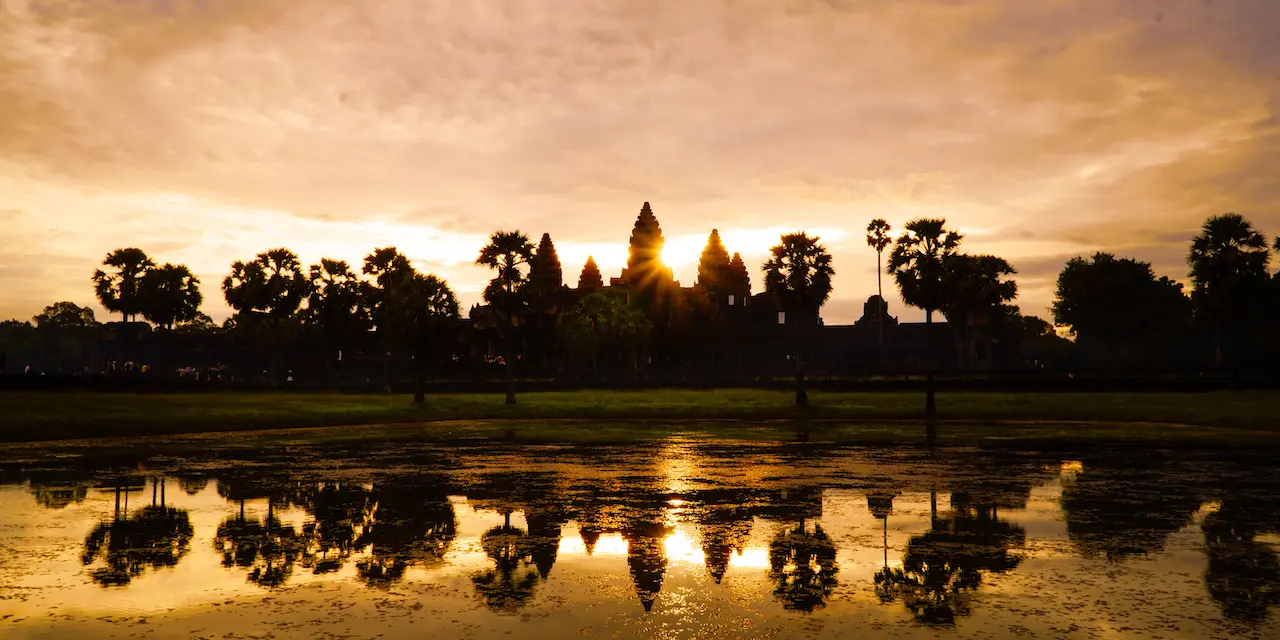
Sunrise at Angkor Wat

Architectural Masterpiece
Angkor Wat symbolizes a miniature universe in stone, with the central tower representing the mythical mountain Meru at the center of the universe. The five towers correspond to Meru’s peaks, while the outer wall represents mountains at the world’s edge and the surrounding moat symbolizes oceans beyond.
Angkor Wat’s architecture is a captivating blend of complexity and beauty, best appreciated from a distance. Initially appearing as a colossal stone mass with a long causeway leading to the center, up close, it reveals a fascinating structure of elevated towers, galleries, chambers, and courtyards on various levels, interconnected by stairways.
Reaching a remarkable height of 213 meters (699 feet), Angkor Wat showcases a tiered design with three levels, each progressively smaller and higher. Covered galleries define the first and second levels, while the third level features five prominent towers. The overall profile mimics a lotus bud, with a striking arrangement known as a quincunx.
Angkor Wat’s design resembles a lotus, with distinctive lines drawing the eye horizontally and vertically. The towers are best viewed from specific angles, not visible from the entrance. The architectural layout comprises cross-shaped structures, curved sloping roofs, and decorative tympanums.
Steps within Angkor Wat are strategically placed to compel pauses, allowing visitors to appreciate the beauty around them. Repetitive architectural elements like galleries, towers, roofs, and steps contribute to the monument’s sense of height and connectivity.
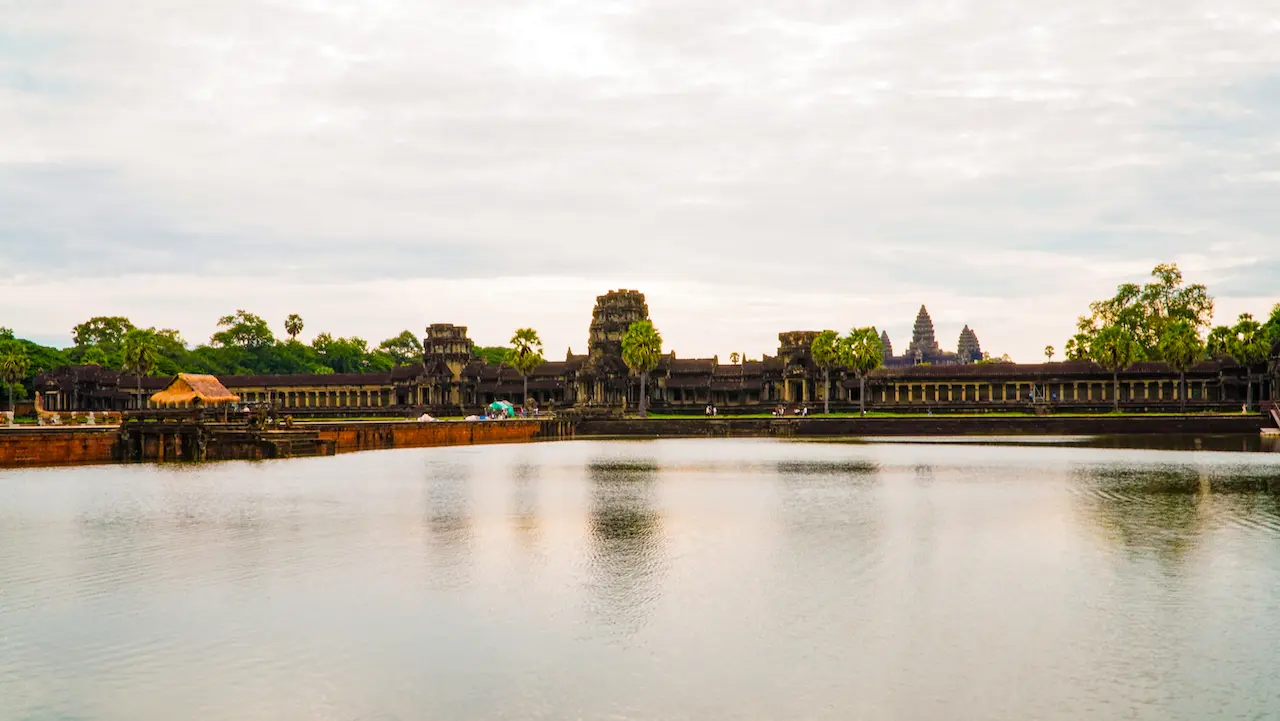
Angkor Complex


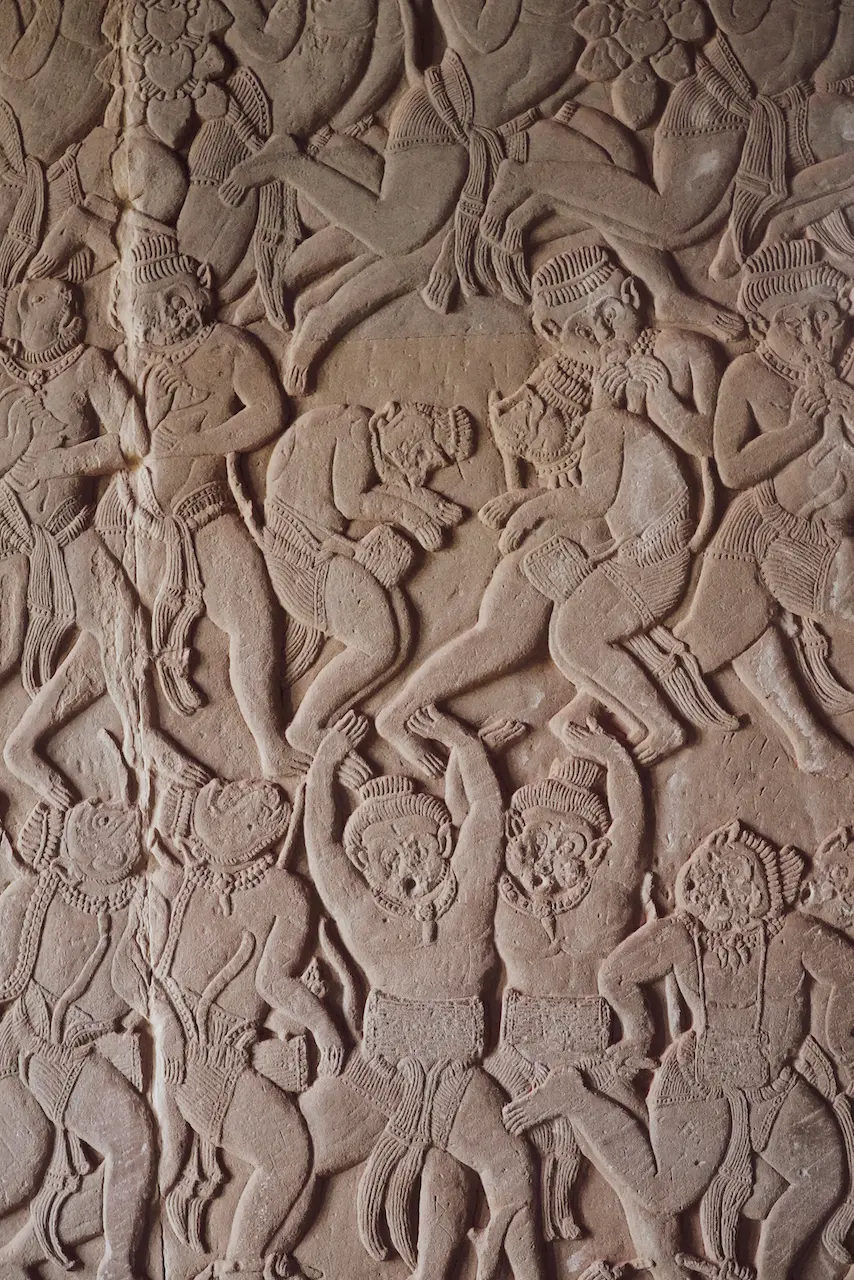
The captivating bas-reliefs on corridors

Ta Promh
The Ancestor Brahma, Jungle Temple
Step into the mystical realm of Ta Prohm, a place where time has woven a tapestry of beauty through its ancient ruins. This hidden gem in Cambodia whispers tales of the past, inviting explorers to unravel its secrets with delight, leaving a trace of longing when it’s time to bid farewell.
Nestled in the southwest of East Mebon and to the east of Angkor Thom, Ta Prohm sits gracefully, embraced by the corner of Banteay Kdei. To embark on this adventure, enter through the western gates and exit from the enchanting eastern entrance.
Picture this: in the mid-12th century to the early 13th century (1186), King Jayavarman VII crafted this marvel as a tribute to his mother, following the divine Bayon art style. As you wander through its ancient corridors, you can almost feel the echoes of history and the devotion that once graced these hallowed halls.
Ta Prohm stands as the unrivaled capital of the ‘Kingdom of the Trees,’ where nature and history entwine in an exquisite dance. Left largely untouched by the hands of archaeologists, it offers a glimpse into the awe that early explorers felt in the 19th century.
Imagine wandering through a jungle-cloaked sanctuary, where fig, banyan, and kapok trees playfully embrace the ancient stones, creating a canopy that seems straight out of a romantic tale. As you meander, the essence of this ethereal place weaves around you, much like the roots that entangle the temple’s walls and towers, leaving you captivated, just like a visitor did four decades ago.
Marvel at the ancient Sanskrit inscription etched in stone, sharing glimpses of Ta Prohm’s grandeur - a sprawling complex that once oversaw 3,140 villages. With a vibrant community of 79,365 individuals, including priests, officials, and dancers, this temple was a beacon of cultural and religious importance. While the numbers might be embellished, they still reflect the majesty that Ta Prohm once held.
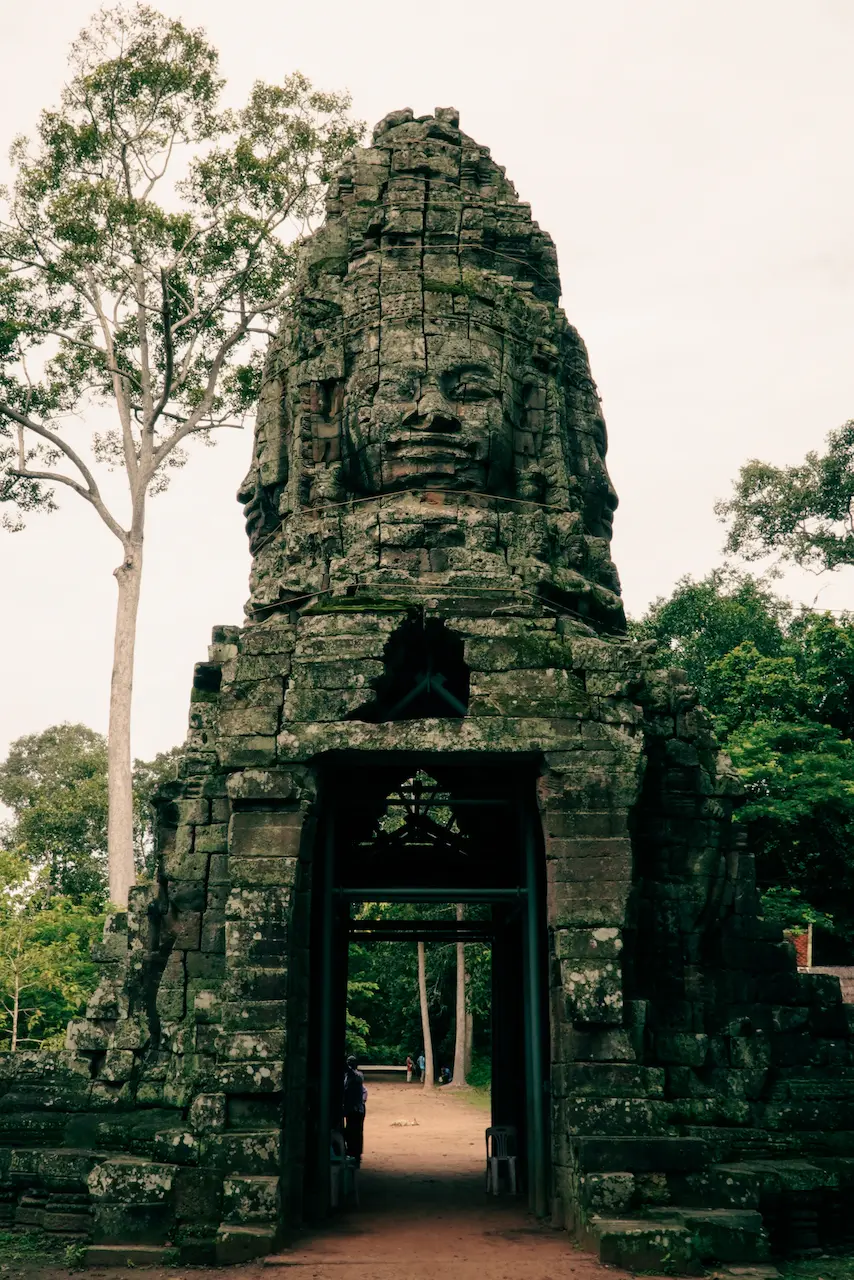
Entrance to Ta Promh
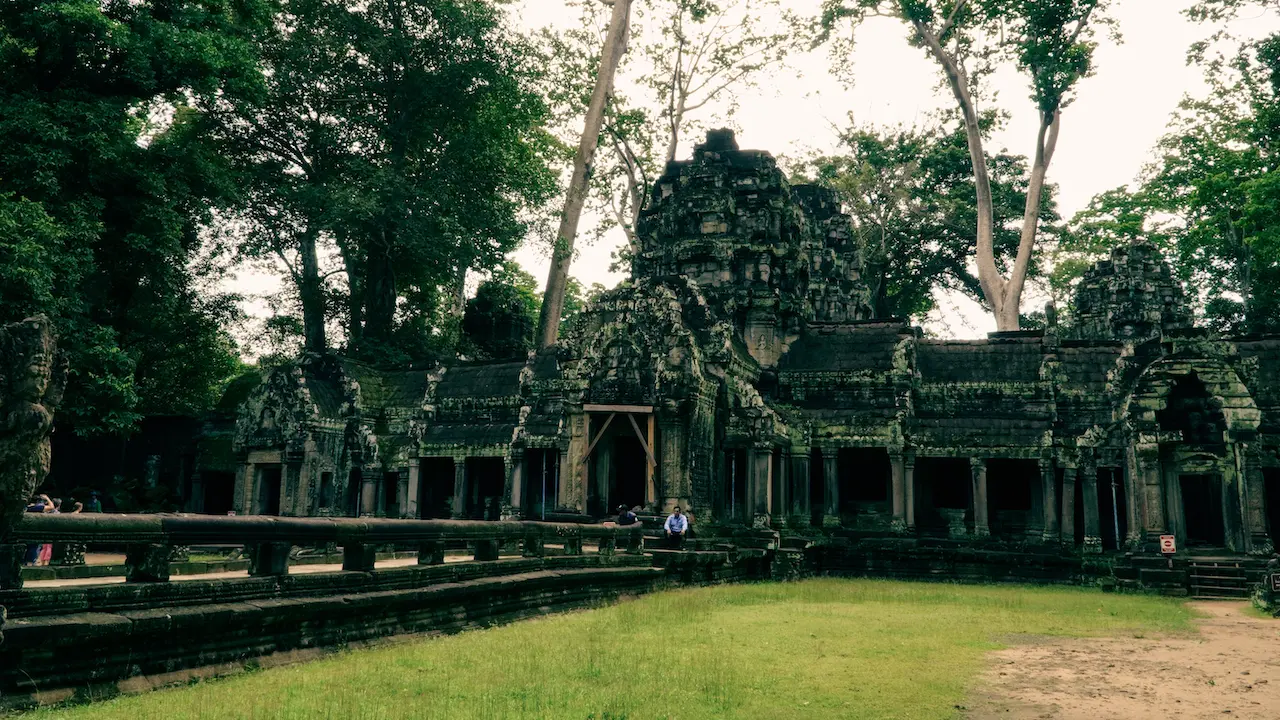
Ta Promh

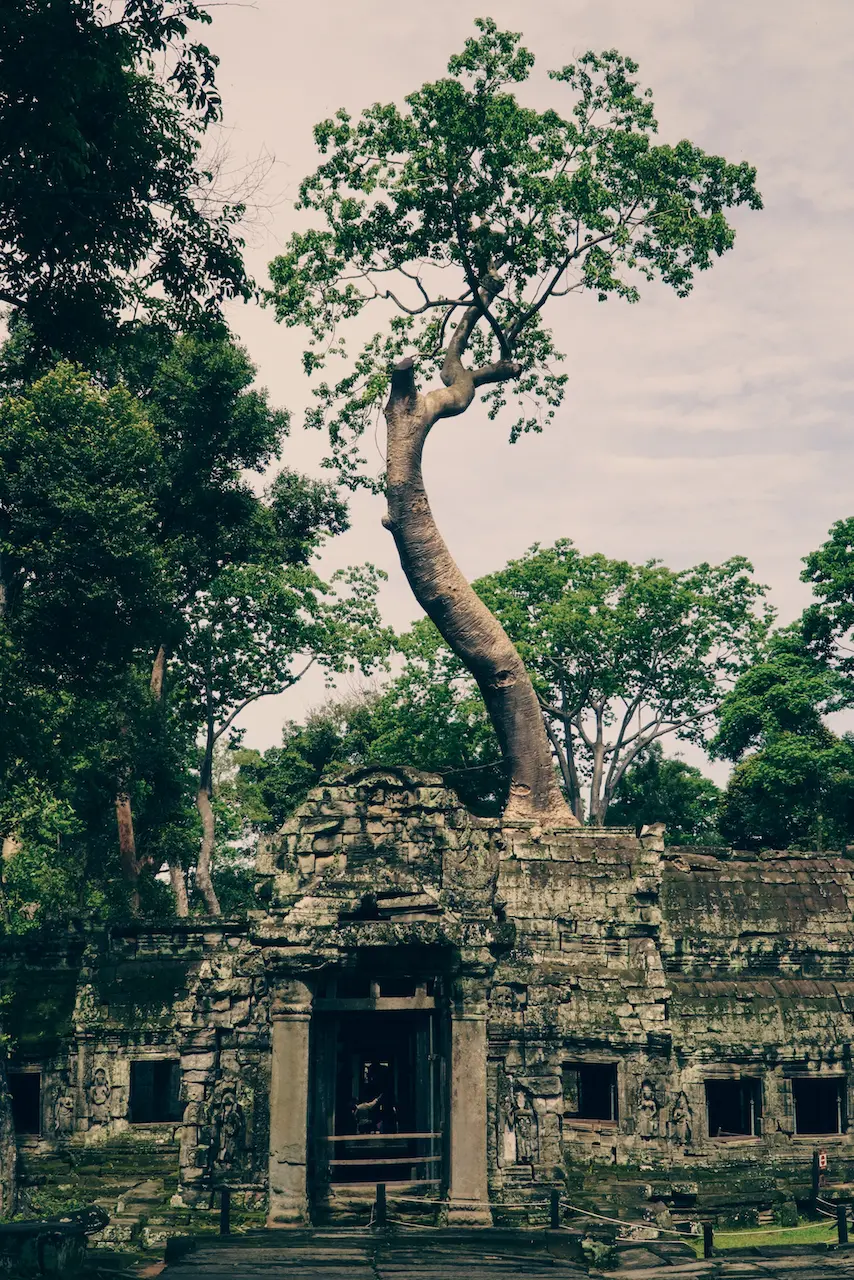

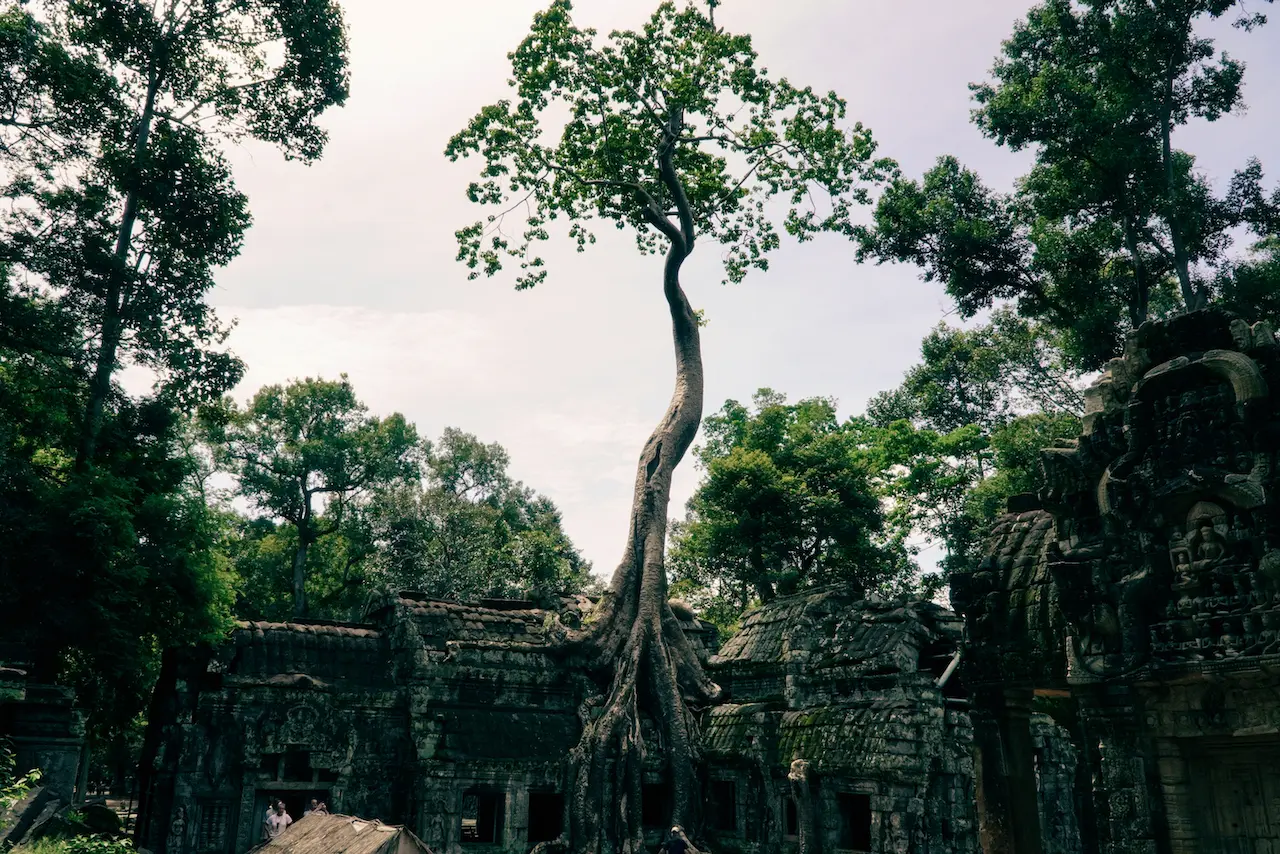
Famous Shot from Lara Croft
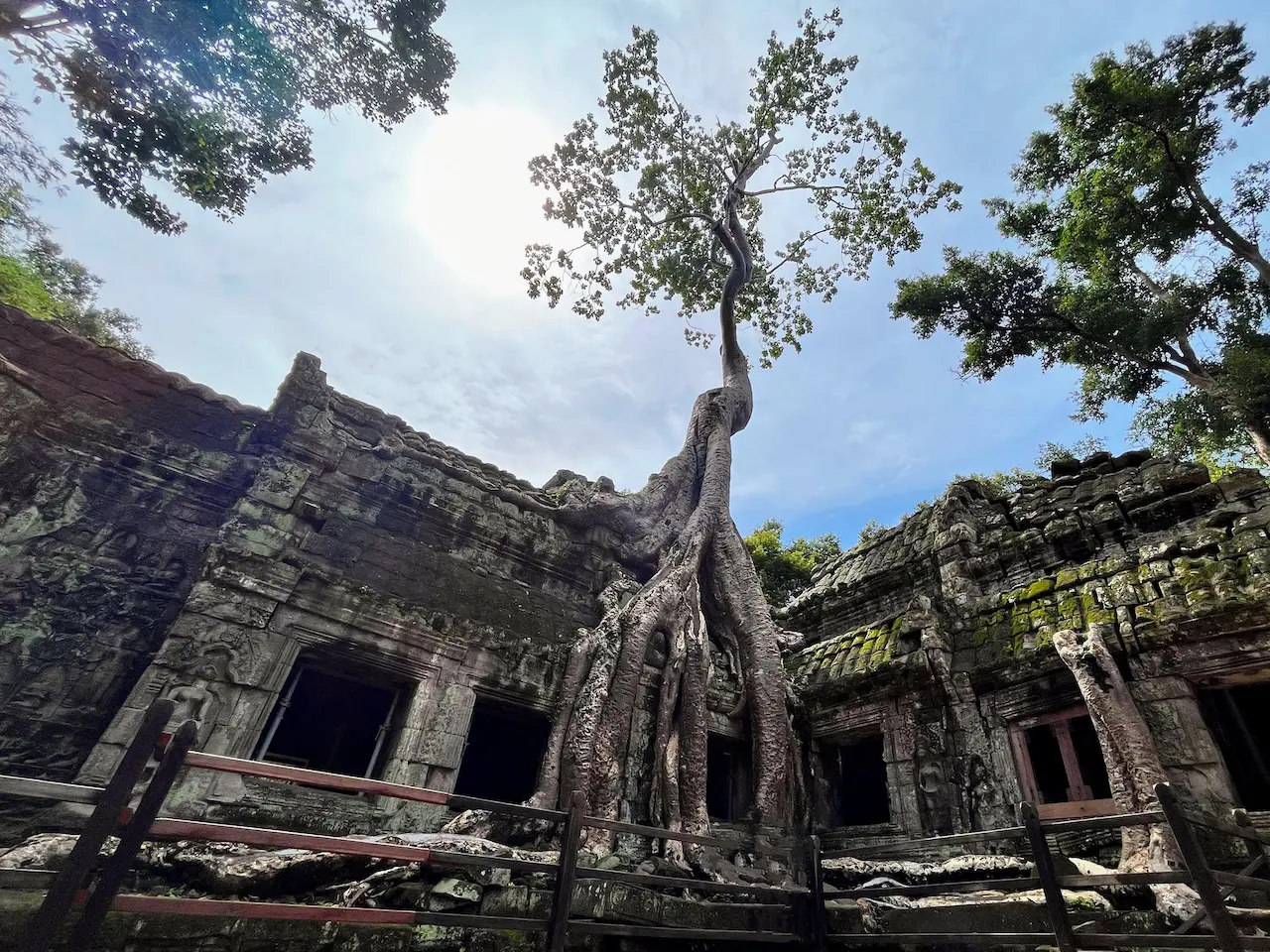
Ta Keo
The Ancestor Keo/Tower of Crystal
Discover the awe-inspiring ziggurat of Ta Keo, a mystical treasure among the lesser-known temples, gracefully reaching for the sun, reminiscent of Angkor Vat. It’s a lush green sanctuary, crowned with trees, rising majestically above the surrounding forest.
Picture rocky formations that seem to have emerged from ancient caverns, soaring above the coconut palms, as if carrying the forest with them on their ascendant journey.
What sets Ta Keo apart is its minimal adornment, a departure from the lavish decorations typical of Khmer architecture. This simplicity, however, is what grants it architectural significance, showcasing the emergence of a new artistic spirit and refined taste in the Khmer civilization.
Located to the east of Thommanon and ChauSay Tevoda, Ta Keo invites you to enter and exit through its welcoming south or east entrances.
Dating back to the late 10th century to early 11th century, this masterpiece was commissioned by King Jayavarman V and dedicated to Siva (Hindu), following the magnificent Kleang style of art.
What’s intriguing is that Ta Keo remains a beautiful, albeit unfinished, marvel. The mystery surrounding its incomplete state only adds to its allure. Imagine the grandeur it would have possessed if completed—it already stands at an impressive height of 22 meters (72 feet), exuding an undeniable sense of power.
Notably, Ta Keo holds the distinction of being the inaugural temple crafted entirely in sandstone, marking a pivotal milestone in Khmer history. The mammoth stone blocks, meticulously shaped and positioned, reflect a straightforward design, setting it apart from its lavishly adorned counterparts. This temple whispers the ancient stories of a bygone era, waiting for you to explore its intriguing mysteries.
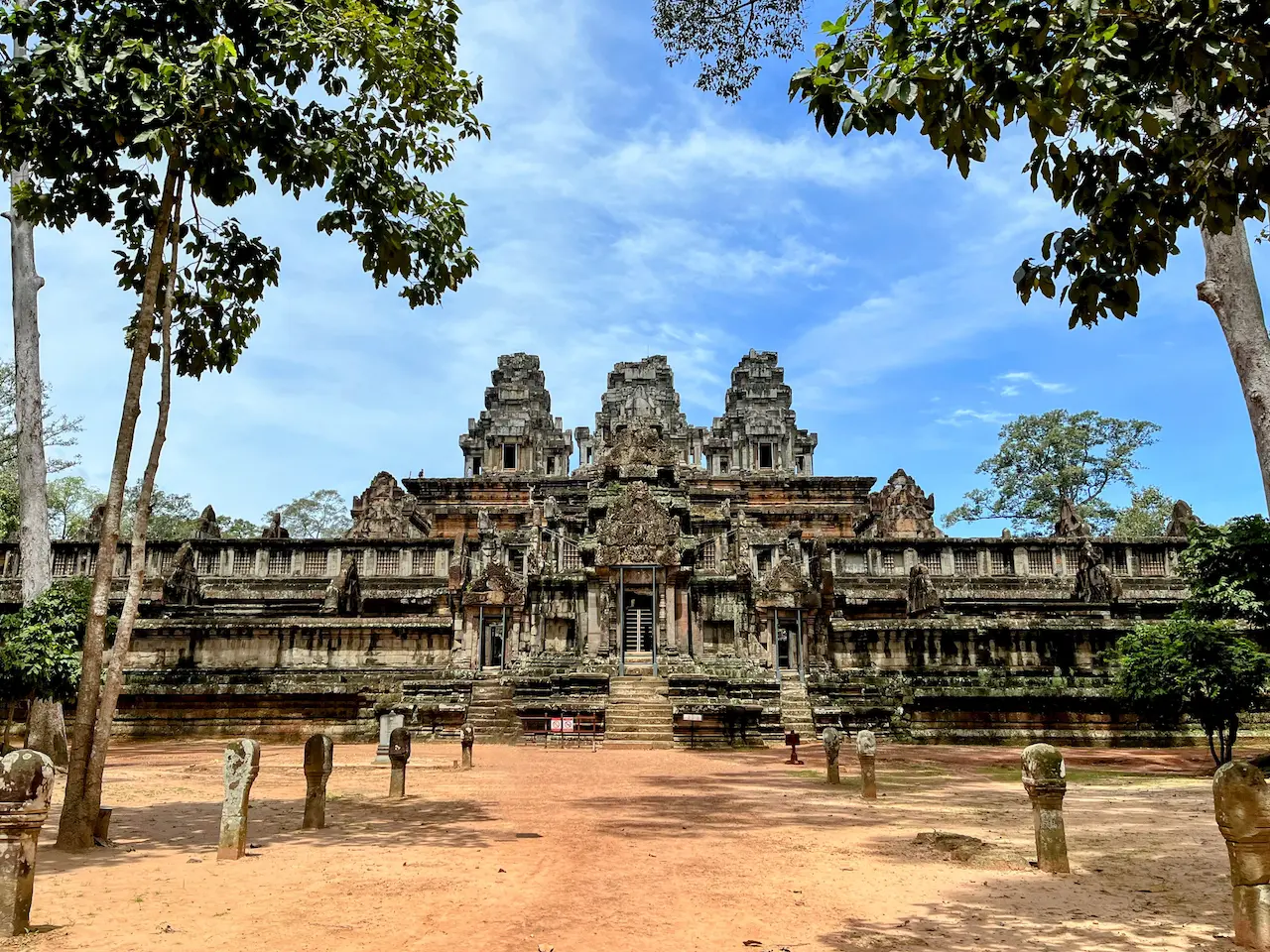
Prasat Ta Keo
Victory gate
Step through the Victory Gate, an imposing entrance adorned with intricate carvings, marking a symbolic passage into the heart of the Angkor Thom complex.
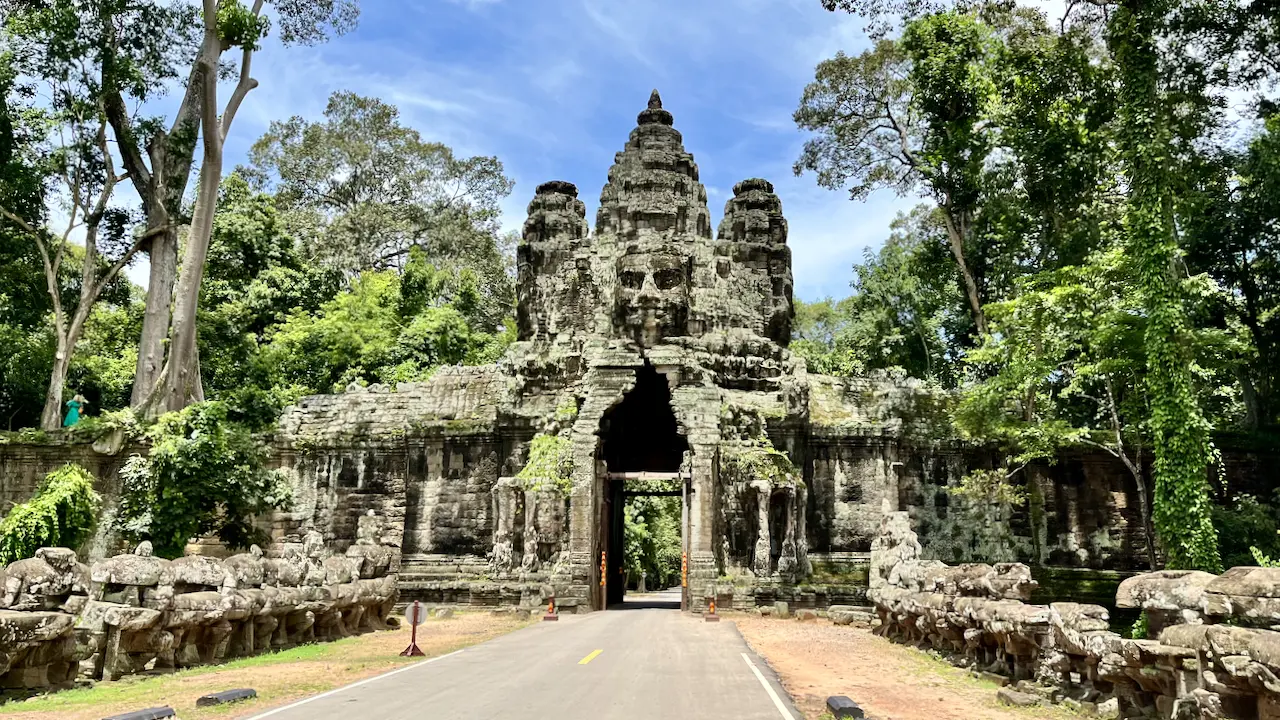
Victory Gate
Bayon
Smile of Angkor
Prepare to be awestruck as you step into the world of the Bayon, a mystical marvel that defies description. Nestled at the heart of Angkor Thom, this ancient wonder is like no other. Standing amidst the lush beauty of the land, the Bayon is a mere 1500 meters (4921 feet) away from the south gate, beckoning explorers to unravel its secrets.
Dating back to the late 12th century to early 13th century, when King Jayavarman VII dedicated it to Buddhism, the Bayon competes with the renowned Angkor Wat for the title of visitors’ favorite monument. Though both elicit similar awe, they differ in purpose, design, architecture, and adornments. The Bayon, shrouded by dense jungle, remained hidden within Angkor’s embrace, its central position in Angkor Thom discovered only after years of mystery.
Initially mistaken as a creation of the ninth century during Yasovarman I’s reign, the Bayon was revealed as a Buddhist temple through a precious find in 1925—a pediment featuring Avalokitesvara. This significant discovery propelled the Bayon’s origins to the late 12th century, leaving it as one of Angkor’s most enigmatic temples, its intricate symbolism and evolving structure yet to be fully deciphered.
A century following the construction of Angkor Wat, the Bayon emerged with its original structure’s early stages shrouded in historical veils. Situated at the heart of a regal city, it likely commenced as a temple-mountain, embodying Mount Meru’s symbolism—a microcosm of divine proportions. Subsequent phases saw the extension of the central structure, ushering the Bayon into its present, awe-inspiring form.
Marvel at the grandeur of the Bayon’s architecture, a testament to human ingenuity and artistry. The temple’s magnificent 54 towers bear witness to over 2000 colossal faces, each a silent enigma. Carved with broad foreheads, lowered lids casting shadows over eyes, and subtly upturned lips, these faces epitomize the ‘Smile of Angkor.’ Believed to embody the bodhisattva Avalokitesvara, they signify the omnipresence of the king, leaving visitors captivated by their mysterious allure.
As you wander through the Bayon’s ancient halls, prepare to be transported to a world where time seems to stand still, and history whispers its secrets in the gentle breeze.
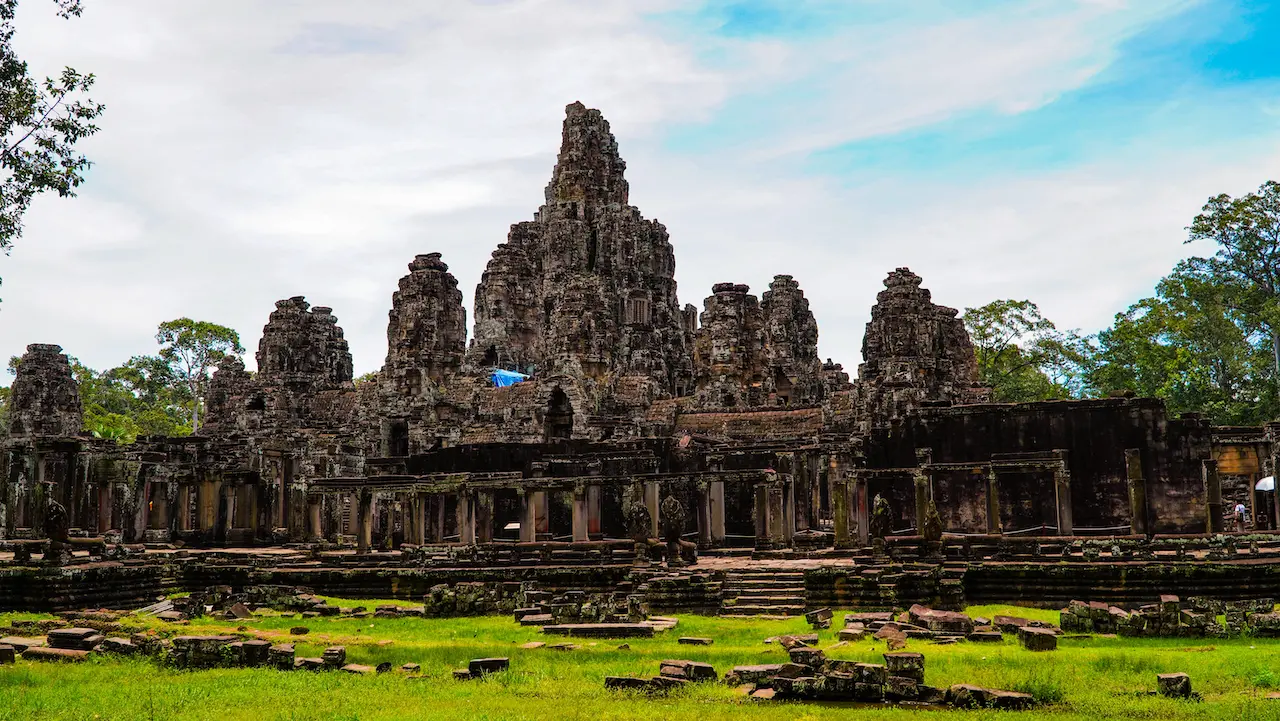
Bayon

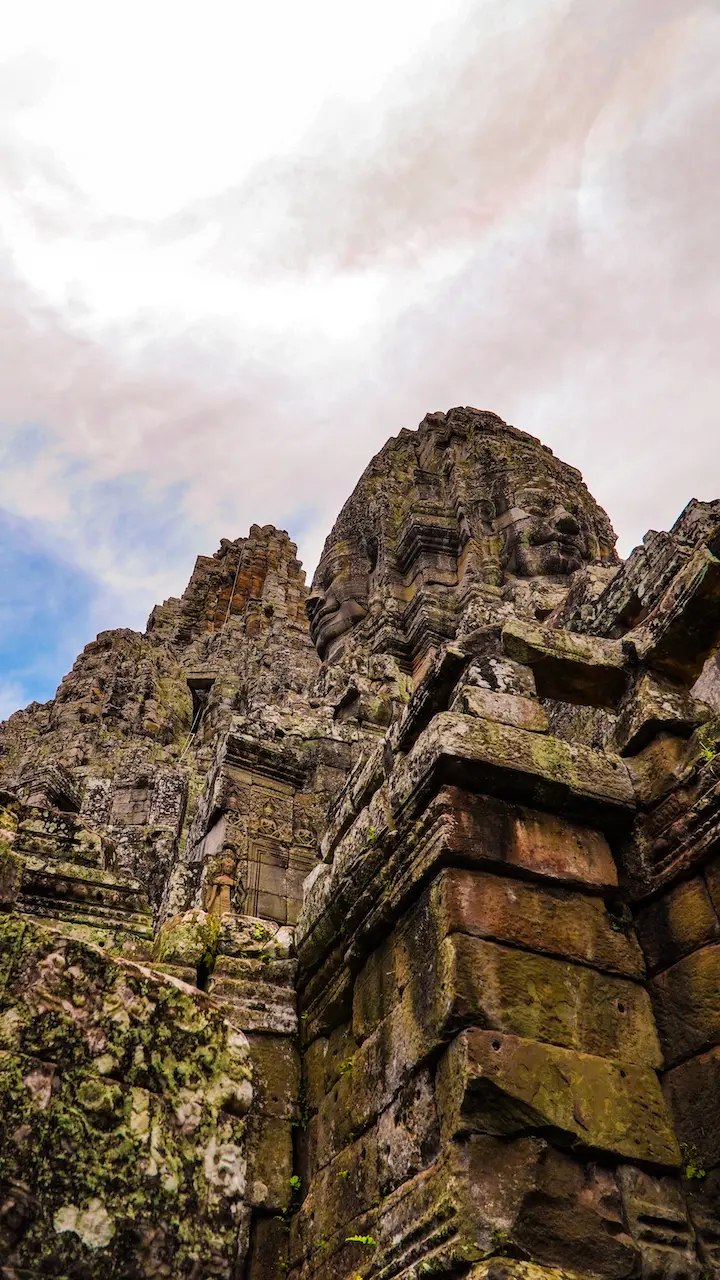



Prasat Khleang Khang Cheung (Prasat North Khleang)
Delve into the ancient ruins of Prasat North Khleang, an architectural marvel showcasing Khmer craftsmanship and design.
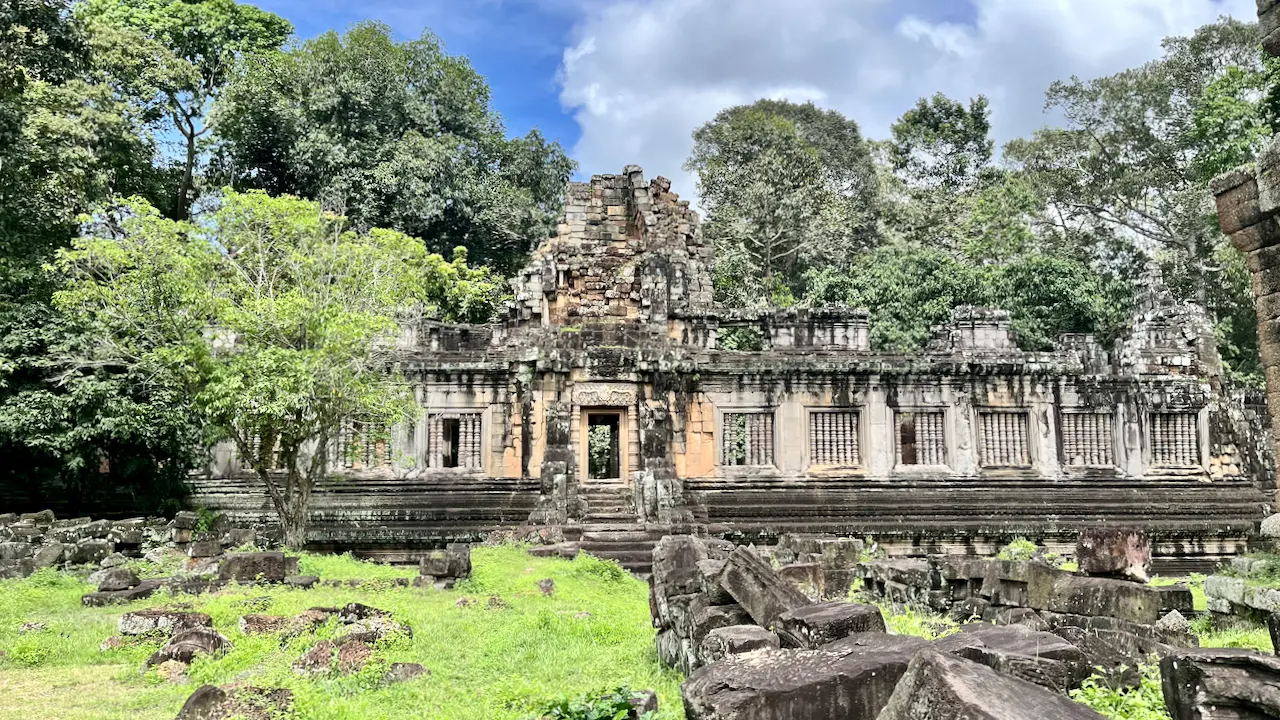
Prasat Khleang Khang Cheung
Terrace of the Elephants
Step into the enchanting realm where majestic Imperial elephants roam through mystical forests. These awe-inspiring creatures, with their formidable presence, make the journey truly magical.
Picture yourself in a forest so lush and thick that only tiny creatures and the mightiest of beings can navigate through its mysterious depths. The undergrowth conceals secrets and hidden pathways, providing a haven for the littlest inhabitants and a passage for grand animals like elephants as they gently tread through the untouched foliage.
Imagine riding on the back of one of these gentle giants, the air filled with a sense of adventure and tranquility as they gracefully stroll, almost as if on a leisurely nature walk. Their even, purposeful steps seem to disregard any obstacle in their path, creating a serene experience amidst the wild.
And to witness this harmonious interaction between nature and royalty, head to the heart of Angkor Thom’s Royal Square. Here lies the awe-inspiring Terrace of the Elephants, an architectural marvel built in the late 12th century. This sacred site, dedicated to Buddhism and crafted in the revered Bayon style, stands as a beautiful replica of ancient artistry, a true testament to the rich history and culture of the region.
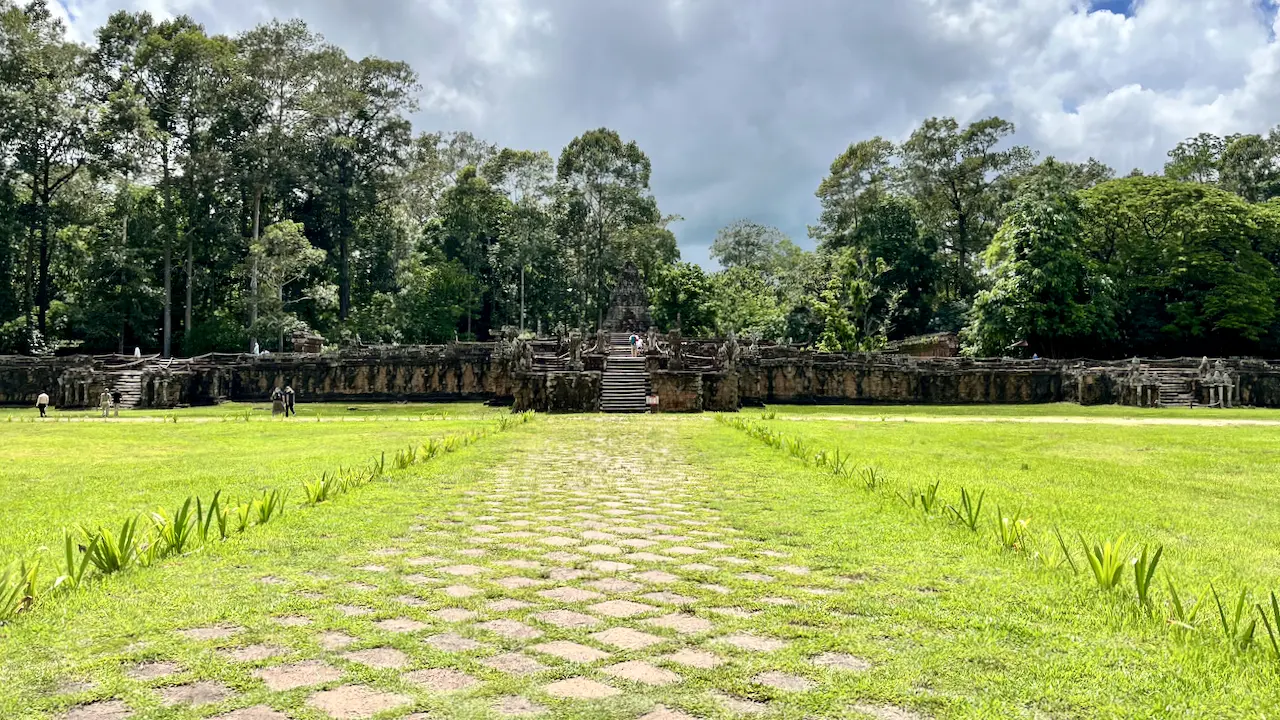
Entrance to Terrace of the Elephants
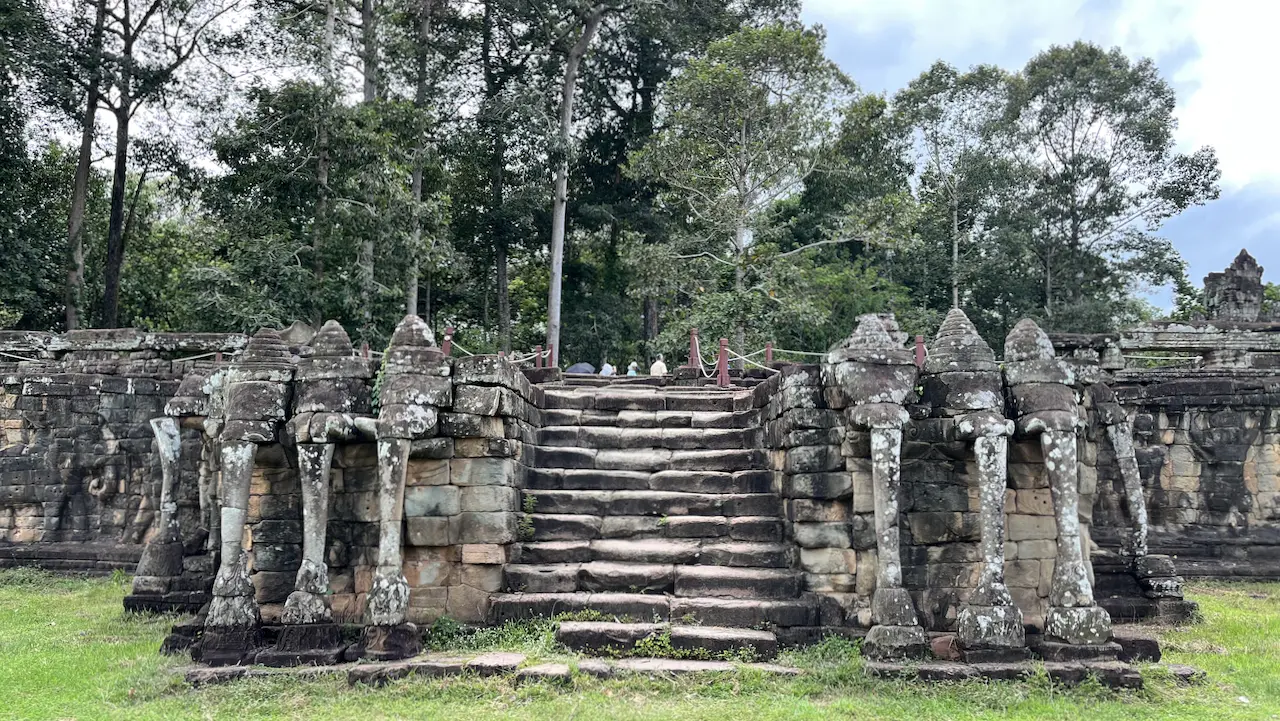
Terrace of the Elephants
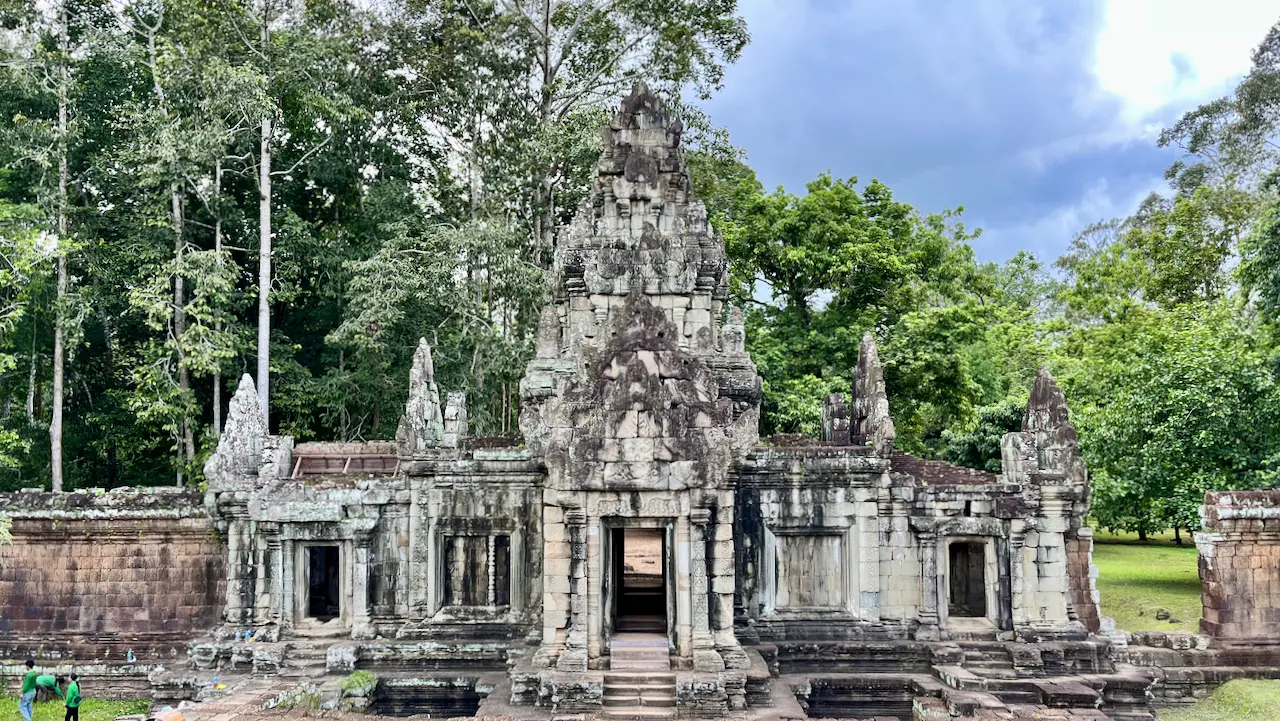
Temple behind the Terrace
Terrace of the Leper King
Welcome to the mesmerizing Terrace of the Leper King, situated just north of the famous Terrace of the Elephants. This stunning historical site, dating back to the 12th century during the reign of King Jayavarman VII, is easily accessible from the main road.
The Terrace of the Leper King echoes the grandeur of Jayavarman VII’s era, boasting intricate bas-reliefs both inside and outside. As explorations continued, the EFEO (École française d’Extrême-Orient) team uncovered a hidden treasure—a second wall adorned with similar captivating bas-reliefs, adding to the allure of this ancient marvel.
Some historians and archaeologists speculate that this secondary wall offers insights into late rites, featuring a two-meter-wide structure made of laterite and adorned with sandstone. Over time, it crumbled, and a new wall, also two meters wide, was constructed in front of it, preserving the intriguing remnants. Thanks to recent efforts by the EFEO, visitors can now venture through a simulated corridor to admire the mesmerizing reliefs on the original wall up close. Step back in time and uncover the secrets of this incredible archaeological gem!
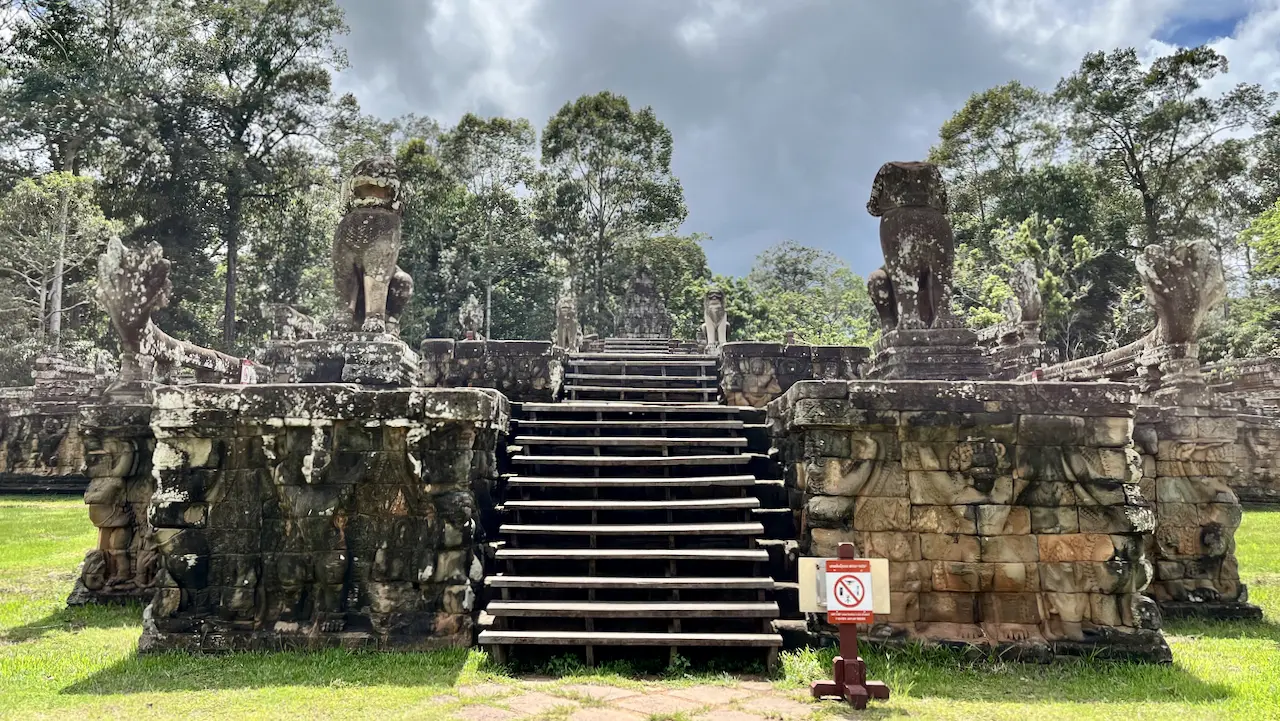
Terrace of the Leper King
Phimeanakas
Aerial Palace
Welcome to Phimeanakas, a hidden gem nestled within the walls of the magnificent Royal Palace of Angkor Thom, just north of Baphuon!
Imagine stepping back in time to the late tenth century and early 11th century, when King Jayavamen V and Udayadityavarman I crafted this divine sanctuary. They dedicated Phimean Akas to Hindu beliefs, adorning it with the splendid Kleang art style.
As you explore, you’ll find Phimeanakas temple near the heart of the Royal Palace area. Although it was once adorned with a golden pinnacle, reminiscent of a Tower of Gold, today it boasts a more rugged charm with its roughly hewn sandstone blocks and minimalistic decorations.
Legend has it that deep within the Royal Palace, there stood a majestic gold tower, Phimeanakas, inhabited by a serpent-spirit with nine heads. This enigmatic spirit would manifest as a woman, captivating the Khmer king, who would spend his nights in the tower before rejoining his other wives and concubines elsewhere in the palace. A fascinating tale that adds to the mystique of this ancient wonder!
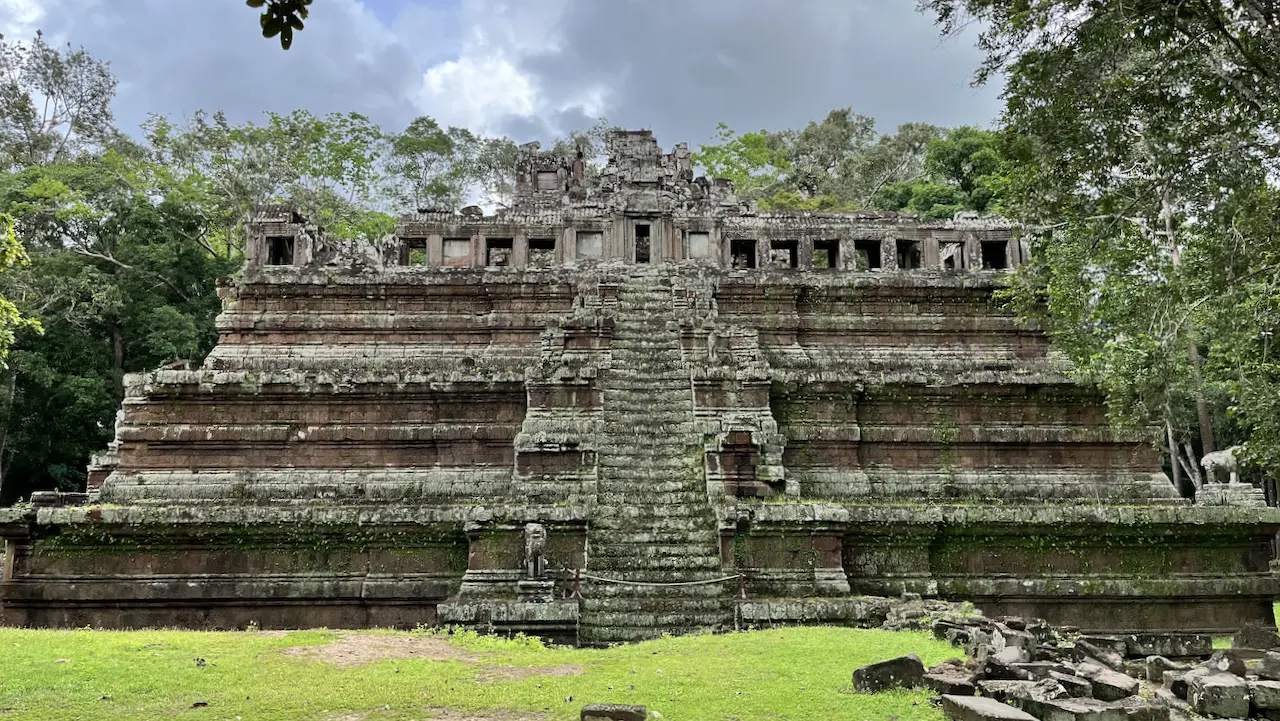
Phimeanakas
Baphuon Temple
A Solitary Sanctuary Temple-Mountain
Welcome to the captivating realm of Angkor Thom, where ancient wonders await your exploration! Venture north of the famed Golden Tower, Bayon, and you’ll encounter the majestic Tower of Branze, also known as Baphuon, reaching even higher than its famed neighbor. Imagine the awe-inspiring sight of this structure, boasting over ten chambers at its base!
While Baphuon’s grandeur was once described in awe by Zhou Daguan, today it wears the marks of time and war, its true splendor somewhat obscured. The French had initiated restoration efforts back in 1972, but the ravages of conflict forced them to abandon the project. Nestled within Angkor Thom’s royal city, this temple predates the city itself, dating back to the eleventh century. Despite its current state, Baphuon still holds fascinating bas-reliefs, offering glimpses into scenes of daily life and the enchanting forest.
Picture Baphuon, a solitary sanctuary temple-mountain, perched atop a lofty base, symbolically representing Mount Meru. Enclosed by a vast rectangular sandstone wall spanning 425 by 125 meters (1394 by 410 feet), this temple exudes an air of ancient mystery. As you approach from the east, a long, elevated sandstone path, extending 200 meters (656 feet), beckons you towards the temple’s heart, supported by three rows of quaint columns. Step into this bygone world and let the whispers of history embrace your senses.
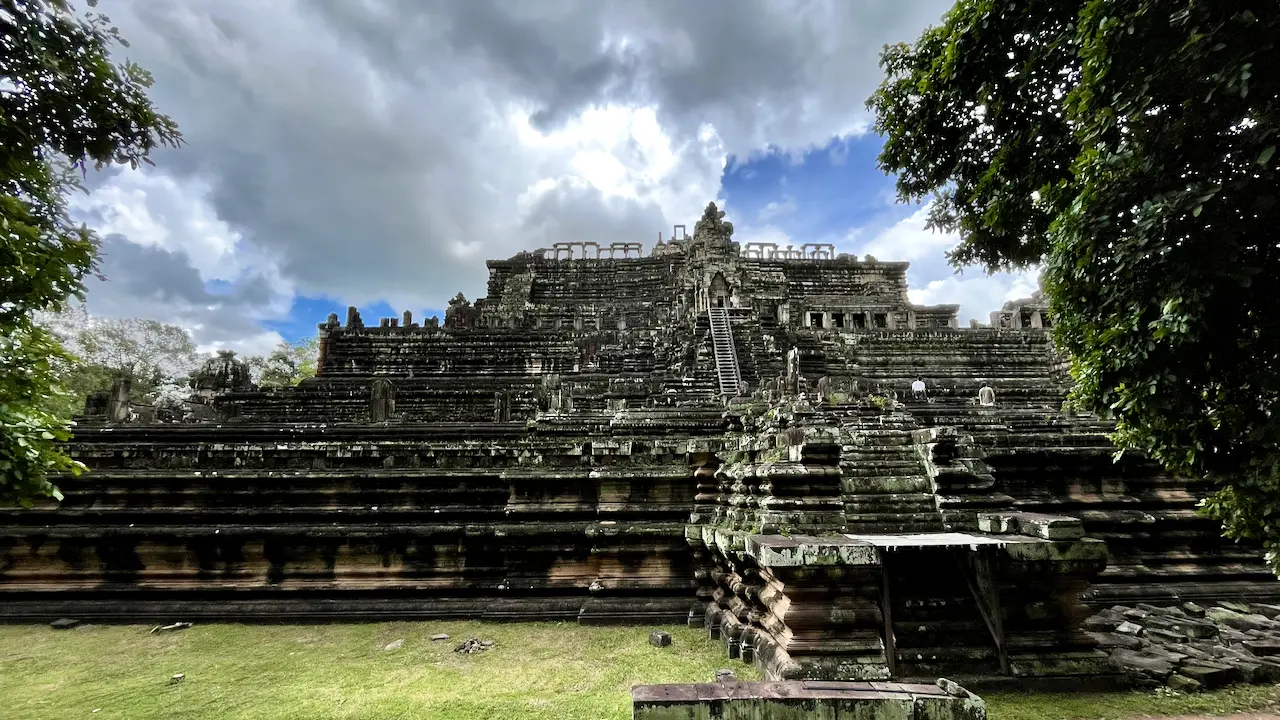
Baphuon Temple

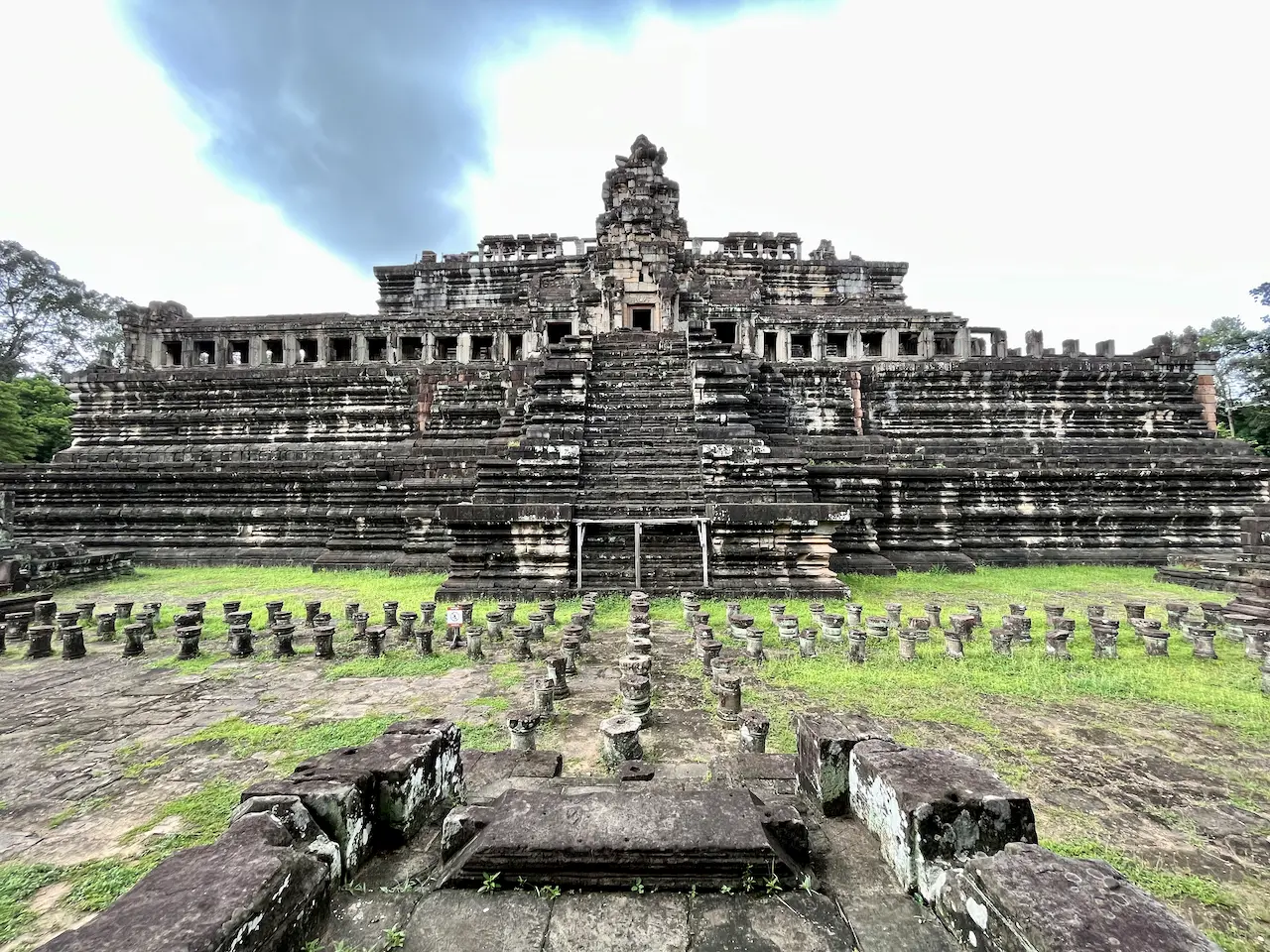
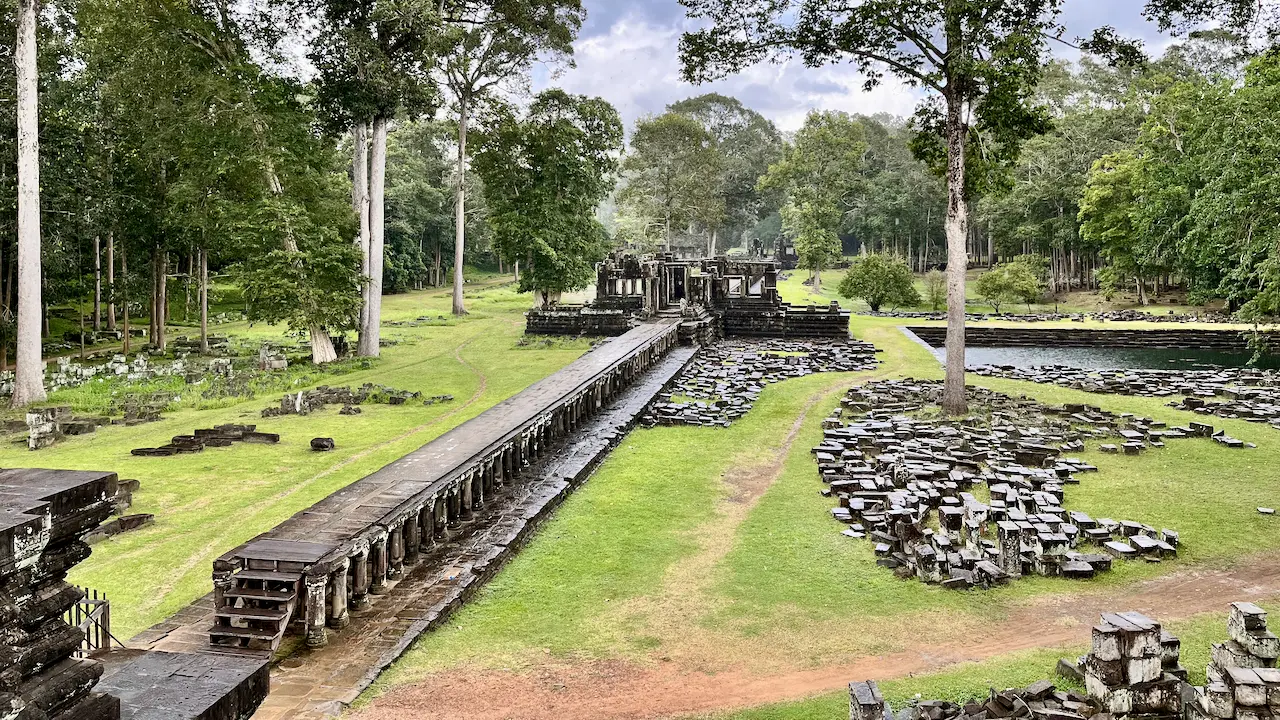
Phnom Bakheng
Discover the mesmerizing Phnom Bakheng, a true testament to the artistry of symmetry and balance. The temple embraces a style that finds its beauty in simplicity, featuring captivating rectangular designs. Picture a majestic pyramid rising in graceful terraces, a sight to behold. As you ascend, each level unveils a world of mystery, shrouded in lush greenery, showcasing the Khmer heritage in all its enigmatic glory.
Located just a stone’s throw away from Angkor Wat, Phnom Bakheng offers a vantage point like no other. Stand at an elevation of 1,30 meters (4,265 feet), and you’ll be enchanted by the panoramic views. To the west, catch a glimpse of the iconic five towers of Angkor Wat. Look southwest and admire the majestic Phnom Krom by the Grand Lake. Northeastward lies Phnom Bok, and to the east, the awe-inspiring Phnom Kulen, all contributing to the enchanting scenery. Don’t miss the vast expanse of the West Baray that adds to the grandeur of the vista.
Steeped in history, Phnom Bakheng’s origins can be traced back to the late ninth to early tenth century, envisioned and built by the visionary King Yasovarman in devotion to Siva. This incredible structure marked the genesis of his capital, Tasoharapura, standing proudly northwest of Roluos. The city was encircled by a four-kilometer-long square wall, with a natural hill at its core that set Phnom Bakheng apart.
Gaze upon the temple’s towers, each one holding a cosmic symbolism that leaves you in awe. Originally adorned with 109 towers, symbolizing Mount Meru, Phnom Bakheng’s towers paint a celestial picture. Though many are no longer present, the remnants convey the temple’s profound meaning. Delve into the 12-year cycle of the animal zodiac as depicted by the brick towers on the tiers. The allure continues with 108 towers, mirroring the lunar phases and the heavenly realms of Hindu mythology, as you explore the levels that grace this ancient wonder.
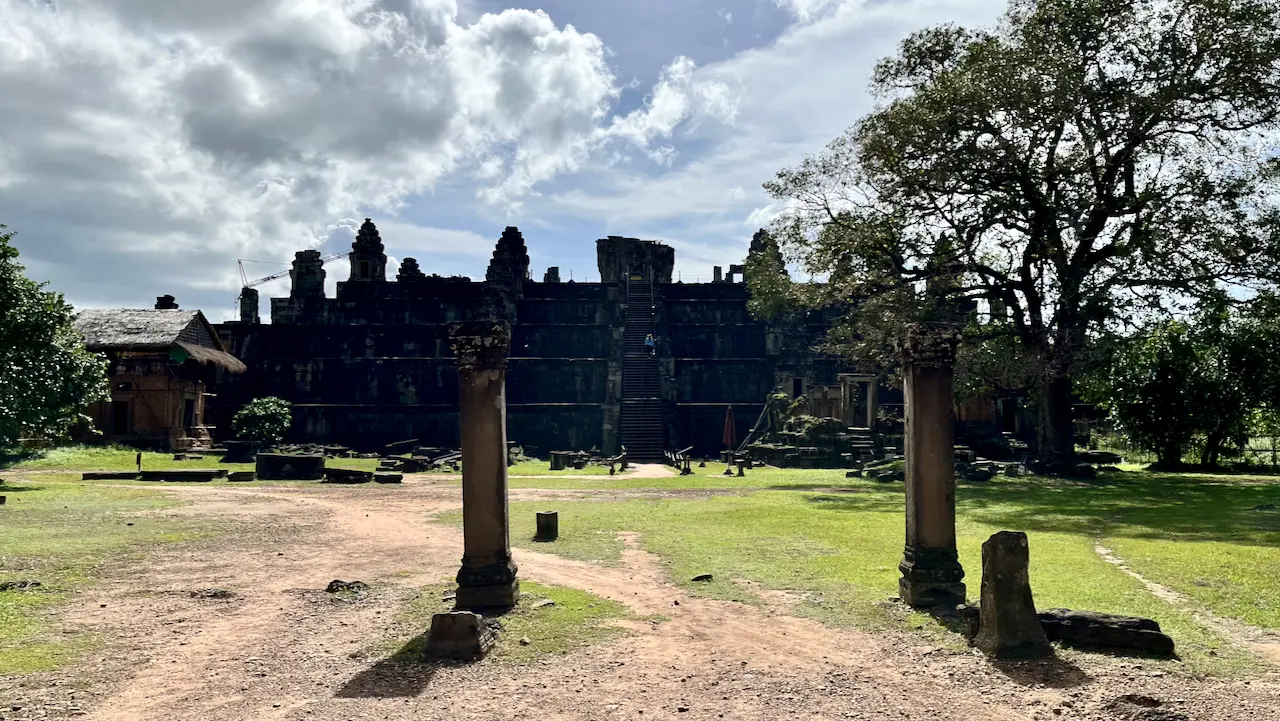
Phnom Bakheng


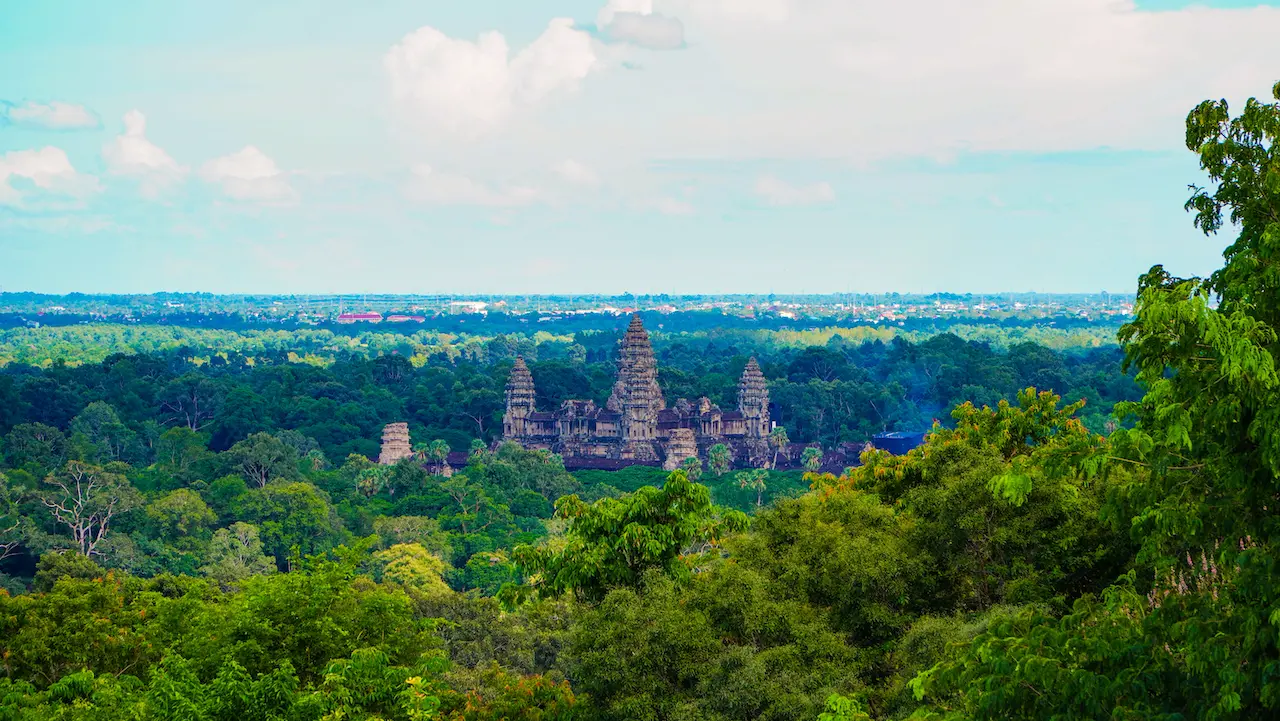
View of Angkor Wat from Phnom Bakheng

Day 3
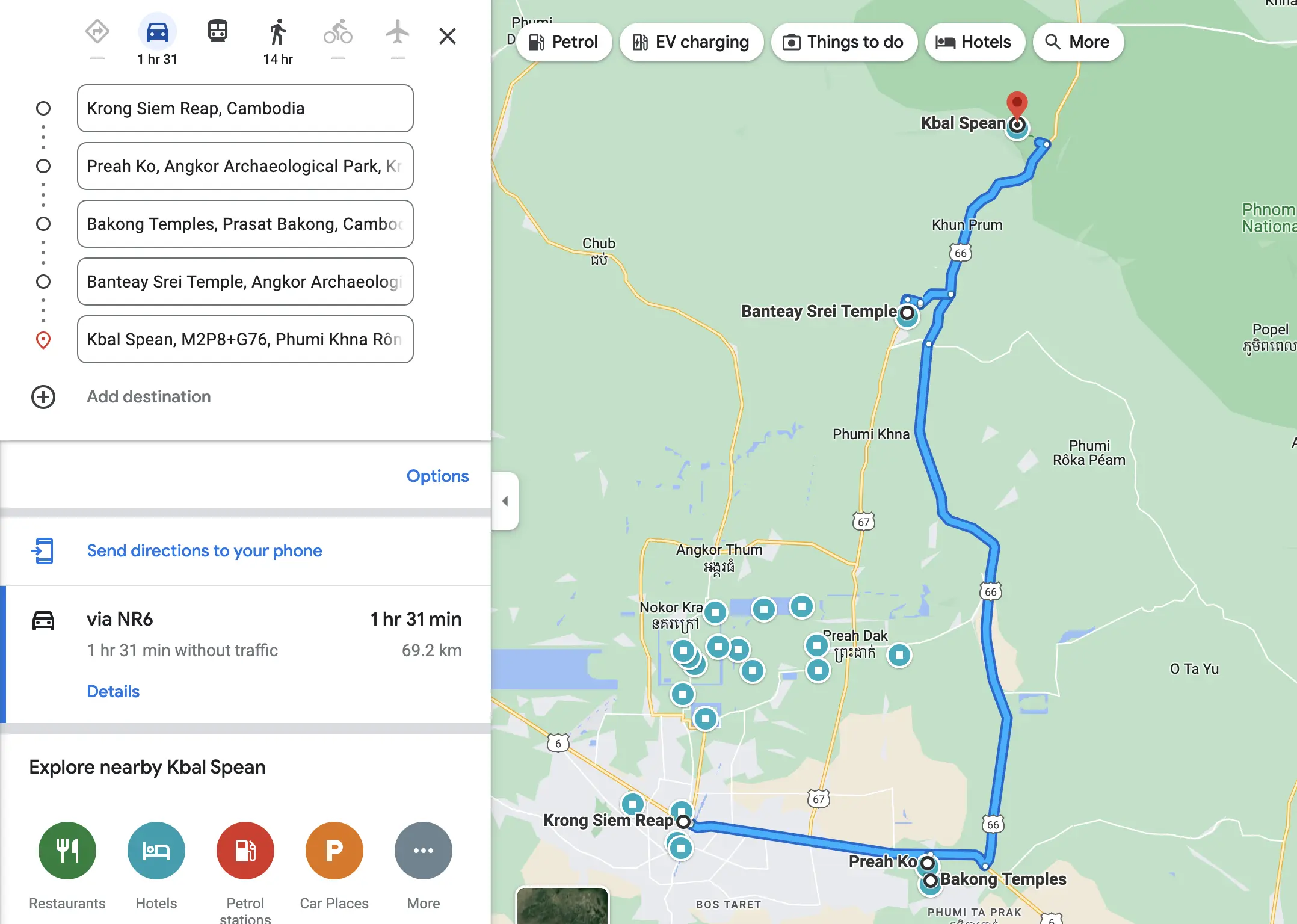
Angkor Wat Itinerary Day 3
Preah ko
The Sacred Ox
Welcome to Prasat Prah Ko, a hidden gem nestled between the enchanting sites of Bakong and Lolei in Roluos, Cambodia. This ancient temple, dating back to the late ninth century (879), was a heartfelt dedication by King Indravarman I to Lord Siva in Hindu tradition.
As you step into this sacred space, you’re stepping into history—a beautiful funerary temple constructed to honor the memories of the king’s parents, maternal grandparents, and even the revered King Jayavarman II and his wife. The architecture and art style echo the mesmerizing Prah Ko design, making it a must-visit for history buffs and architecture enthusiasts alike!
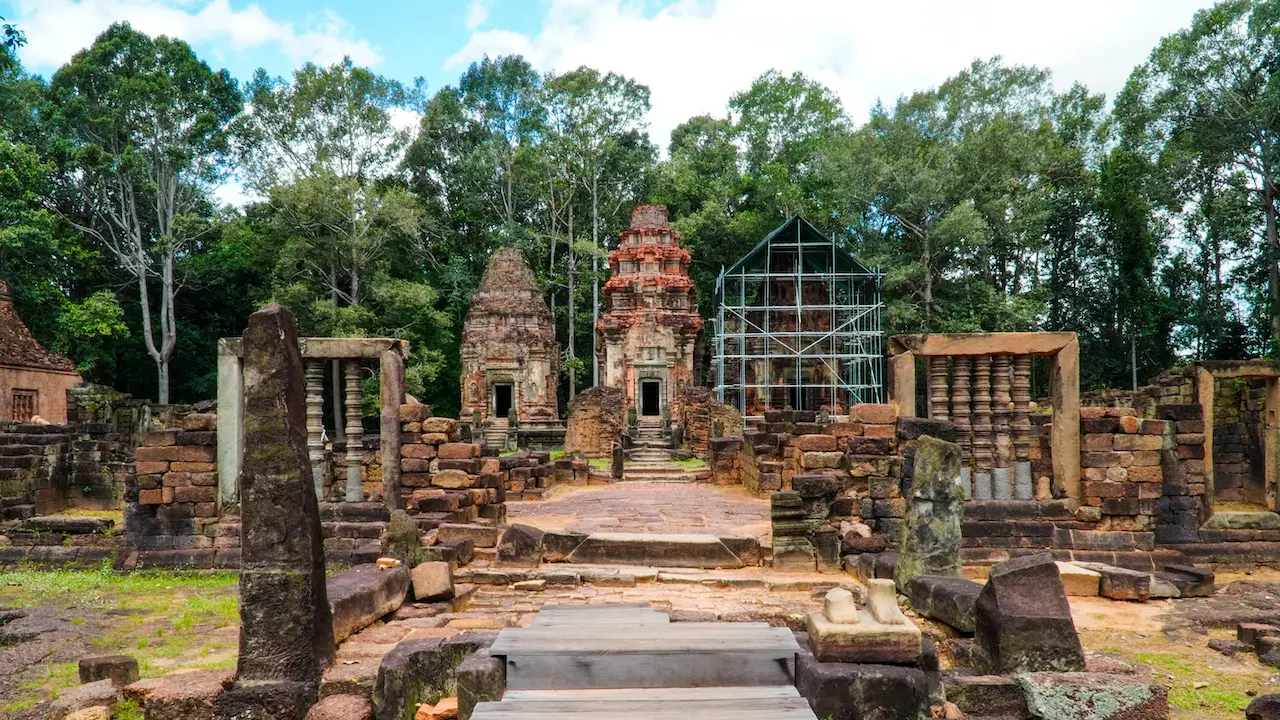
Preah Ko
Bakong
Welcome to Bakong, a hidden gem located just south of Preah Ko in the charming Roluos region. As you venture into this ancient temple, be sure to enter and exit through the east, where you’ll also find a modern Buddhist temple to your right. The construction of Bakong dates back to the late ninth century (881), a remarkable creation by King Indravarman I, dedicated to the Hindu deity Siva, reflecting the Prah Ko art style of that era.
In its heyday, Bakong stood proudly at the heart of Hariharalaya town, named after the divine fusion of Siva and Visnu, known as Hari-Hara. The temple itself is a symbolic representation of the mystical Mount Meru, a connection to the cosmic realm.
As you ascend through the four levels leading to the Central Sanctuary, you’ll journey through the realms of mythical beings—Nagas, Garudas, Raksasas, and Yaksas—each level unveiling a deeper connection to this ancient and enchanting place. Bakong invites you to step back in time and immerse yourself in the rich tapestry of history and myth.
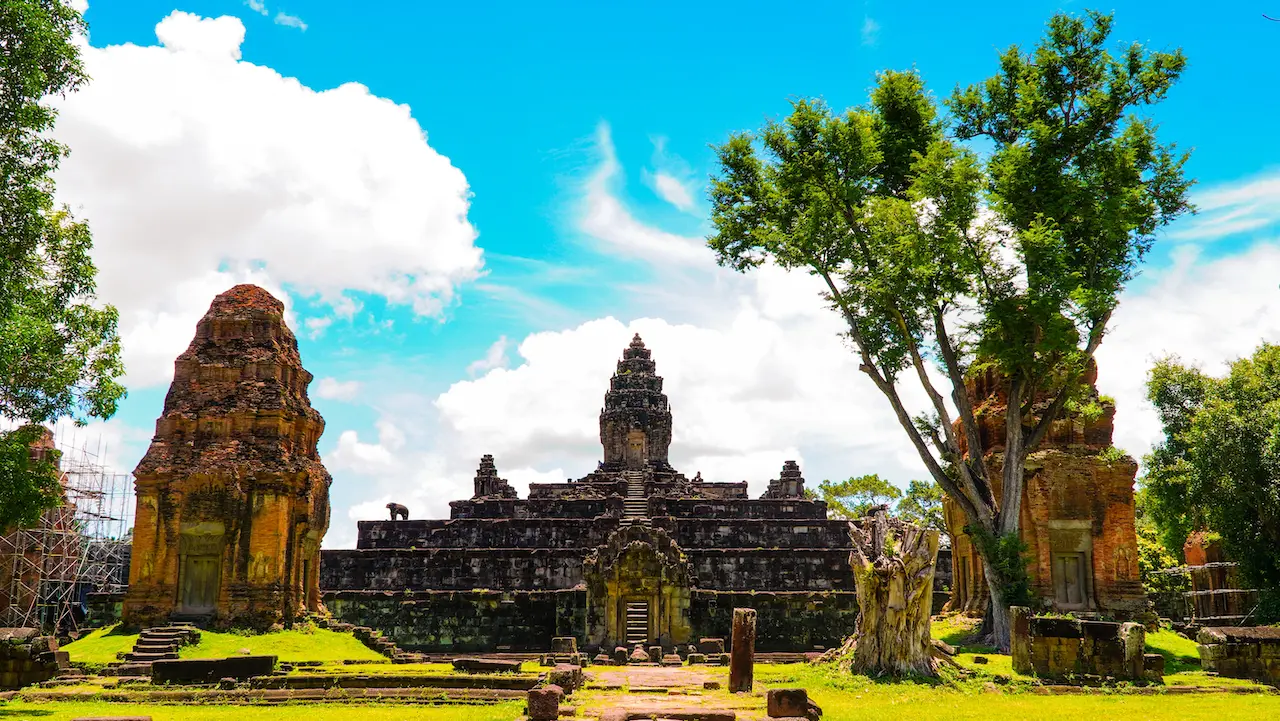
Bakong Temple

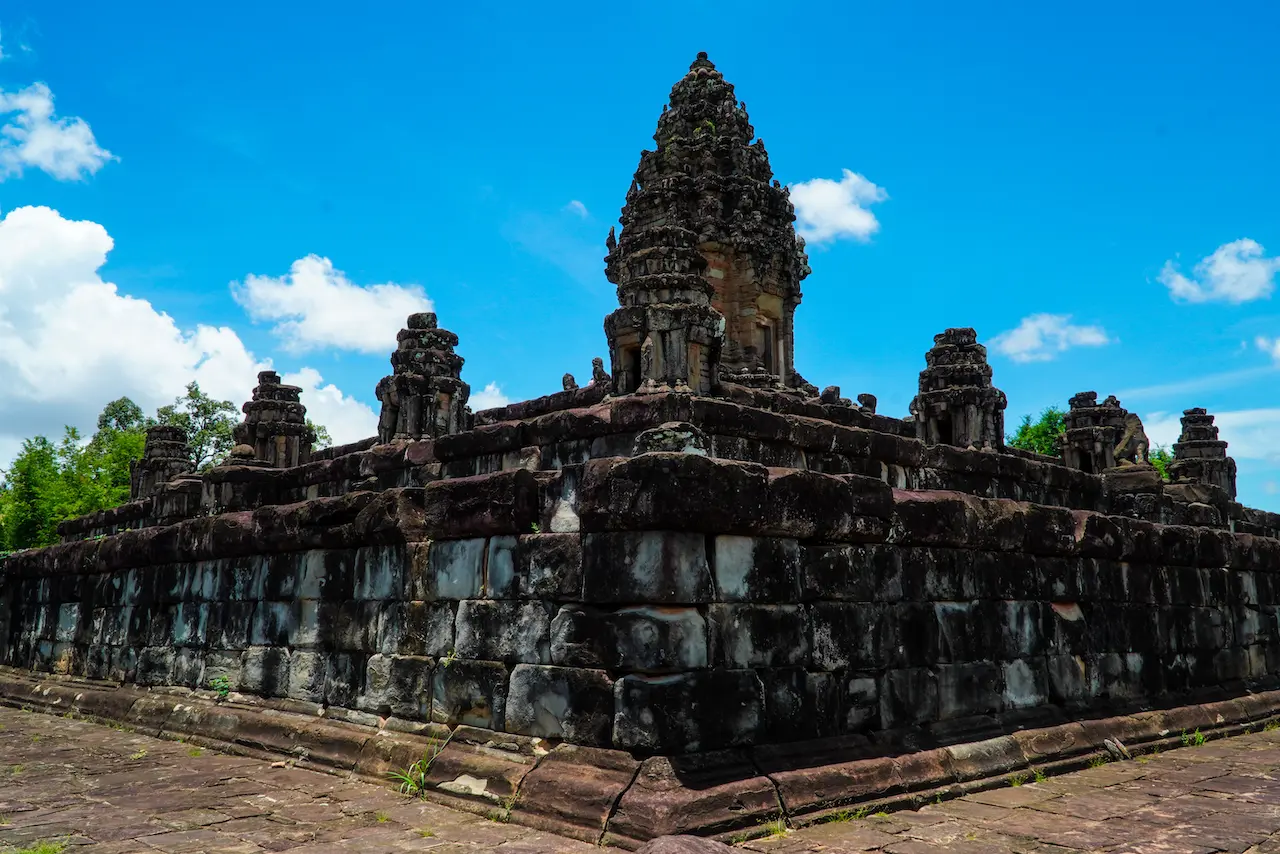

Banteay Srei
The Citadel of the Women
Banteay Srei, also known as the “Citadel of Women,” enchants with its delicate pink sandstone carvings, showcasing remarkable craftsmanship and a more intimate, intricate side of Angkor’s architectural beauty.
Discover the enchanting world of Banteay Srei, a temple dating back to the fascinating tenth century. This hidden gem is like a fairy palace tucked away in a mysterious Cambodian forest. Imagine intricate carvings in a beautiful pinkish sandstone that adorn the walls like a tapestry - it’s a sight to behold!
Banteay Srei is often considered the darling of Angkor, capturing the hearts of visitors with its small yet wonderfully preserved structure and exquisite decoration. As you explore, you’ll find it hard not to be charmed by its unique allure.
French archaeologists have affectionately dubbed Banteay Srei a ‘precious gem’ and a ‘jewel in Khmer art.’ Originally known as Isvarapura, this architectural marvel was crafted by a Brahmin of royal lineage and spiritual guide to Jayavarman V. Its distinctive architecture and intricate decoration draw inspiration from Indian models, creating a blend of artistry that’s truly remarkable. Don’t miss the chance to witness the magic of sandalwood-like carvings in solid pink sandstone - an experience that will transport you to a different world!
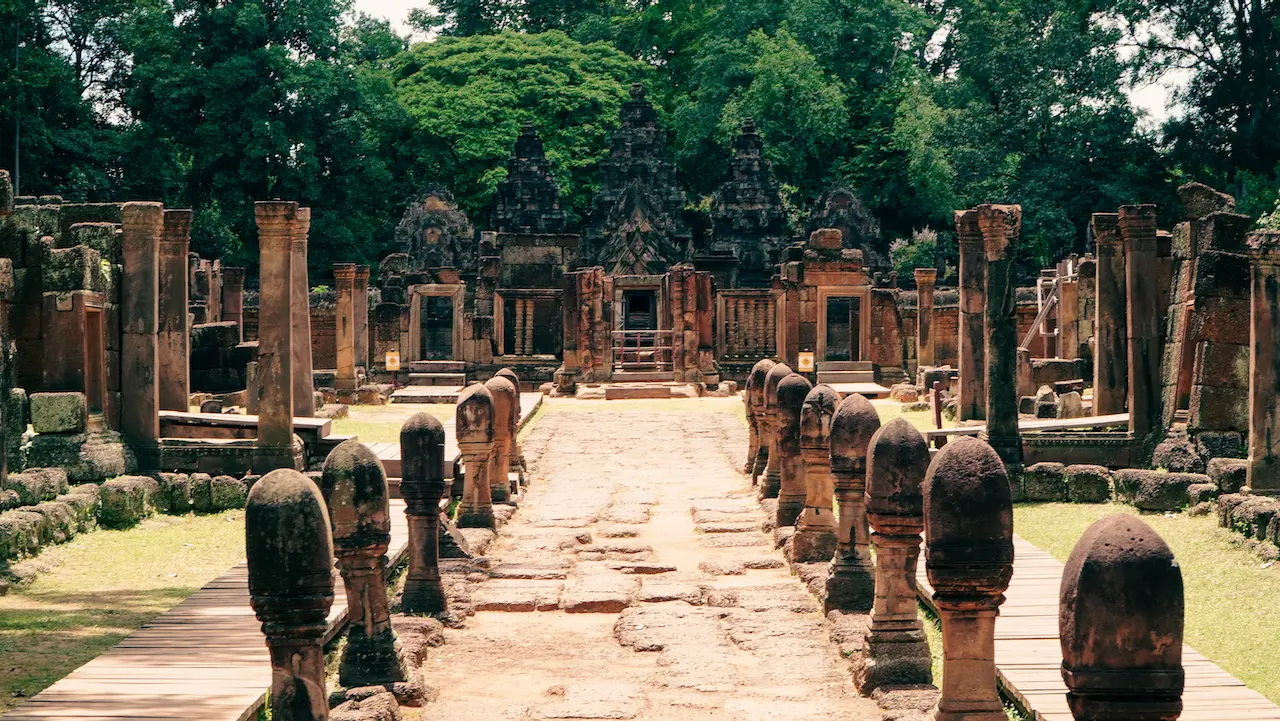
Banteay Srei Temple

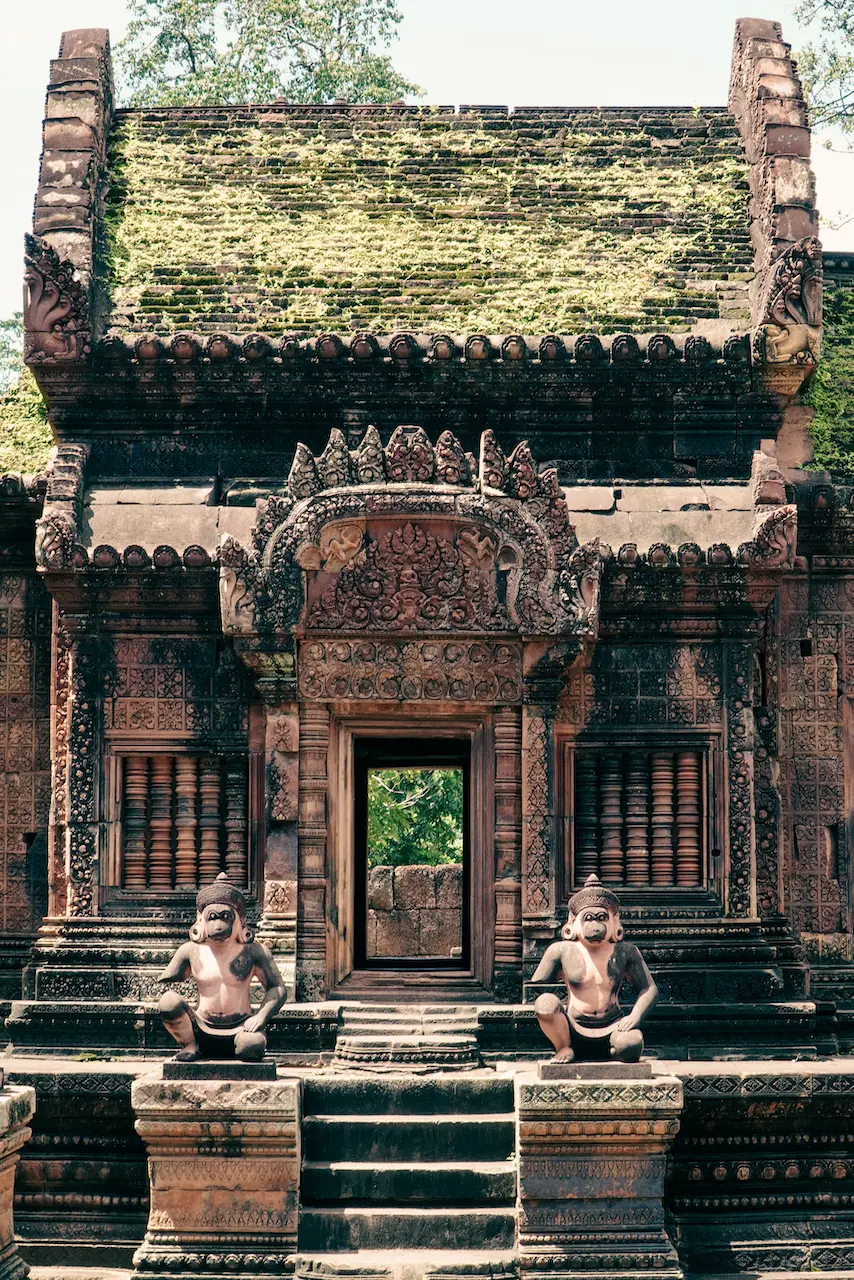

Kbal spean
River of a Thousand Lingas
Kbal Spean, often called the “River of a Thousand Lingas,” is a sacred riverbed adorned with ancient linga carvings, hidden amidst the lush Cambodian jungle, offering a unique and spiritual trekking experience for those seeking ancient wonders in a natural setting.
Discover the hidden gem of Kbal Spean, located just 50 kilometers northeast of Siem Reap’s provincial town or a mere 18 kilometers from the enchanting Banteay Srei temple, accessible via a rustic dirt road. The journey typically takes one to two hours from Siem Reap.
Imagine a mystical adventure deep within the Cambodian jungle, where the original River of Thousand Lingams, Kbal Spean, awaits your exploration. The riverbed is a canvas of intricately carved lingams—phallic symbols revered in Brahmanism for their fertility symbolism. As you wander through this sacred site, you’ll find hundreds of these ancient carvings etched into the rock, accompanied by depictions of gods and animals, all near a gentle waterfall.
This captivating site remained hidden until 1969 when a local hermit guided French researcher Jean Boulbet to the mesmerizing carvings.
Embark on a delightful 30-minute jungle trek to reach the carvings, passing through lush forest and peculiar rock formations. The trek takes you to the natural rock bridge, giving you a glimpse into the ancient world. For the best experience, plan your visit between July and December when the river flows gracefully, offering a breathtaking display of nature’s beauty. Don’t miss this chance to immerse yourself in both history and nature in the heart of Angkor.
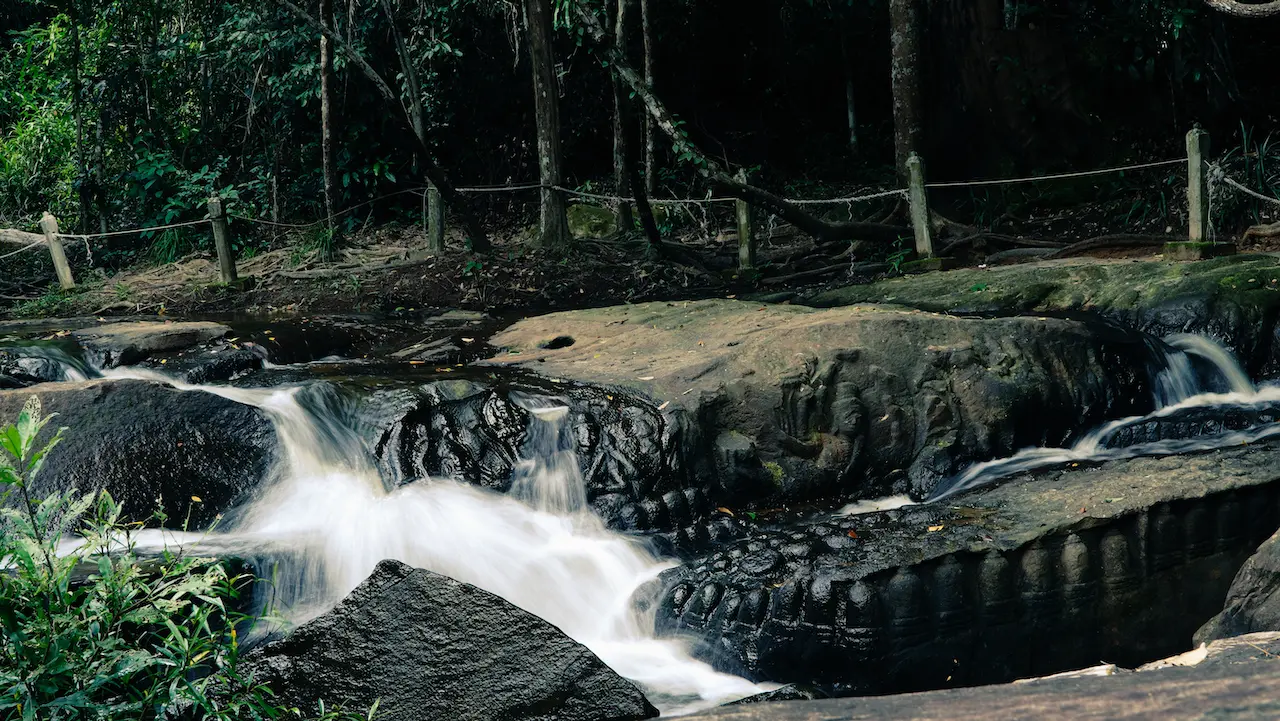
River of a Thousand Lingas
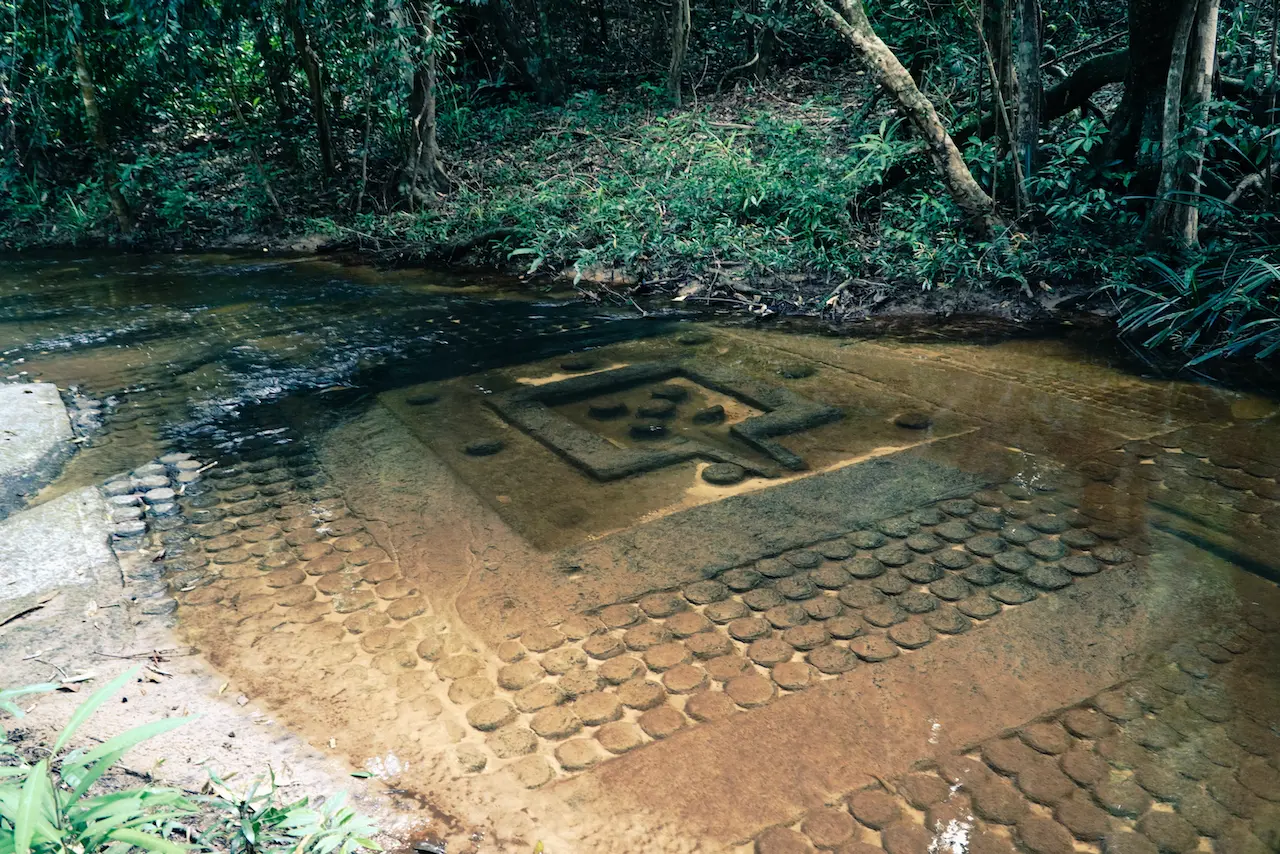
Lingas in Kbal Spean
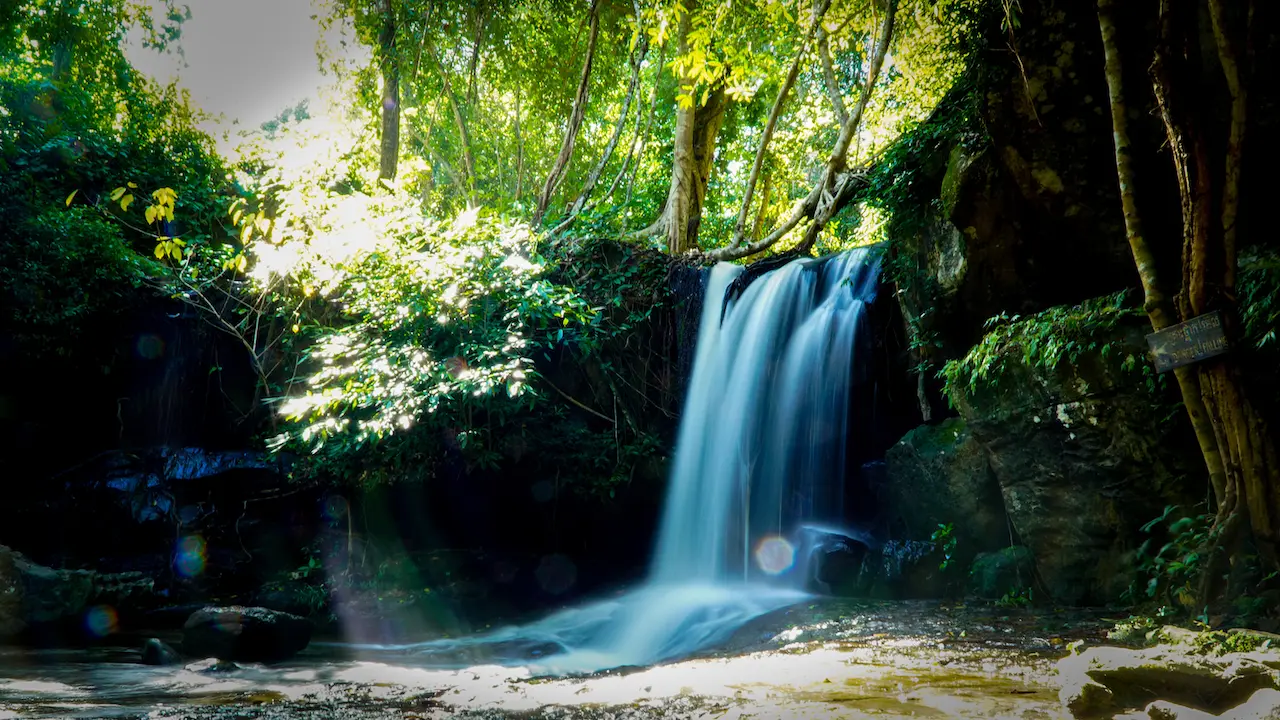
Waterfalls in Kbal Spean

Popular Travel Guides
Our Most Popular Destinations
Latest from the Blog
Find Travel Inspiration

